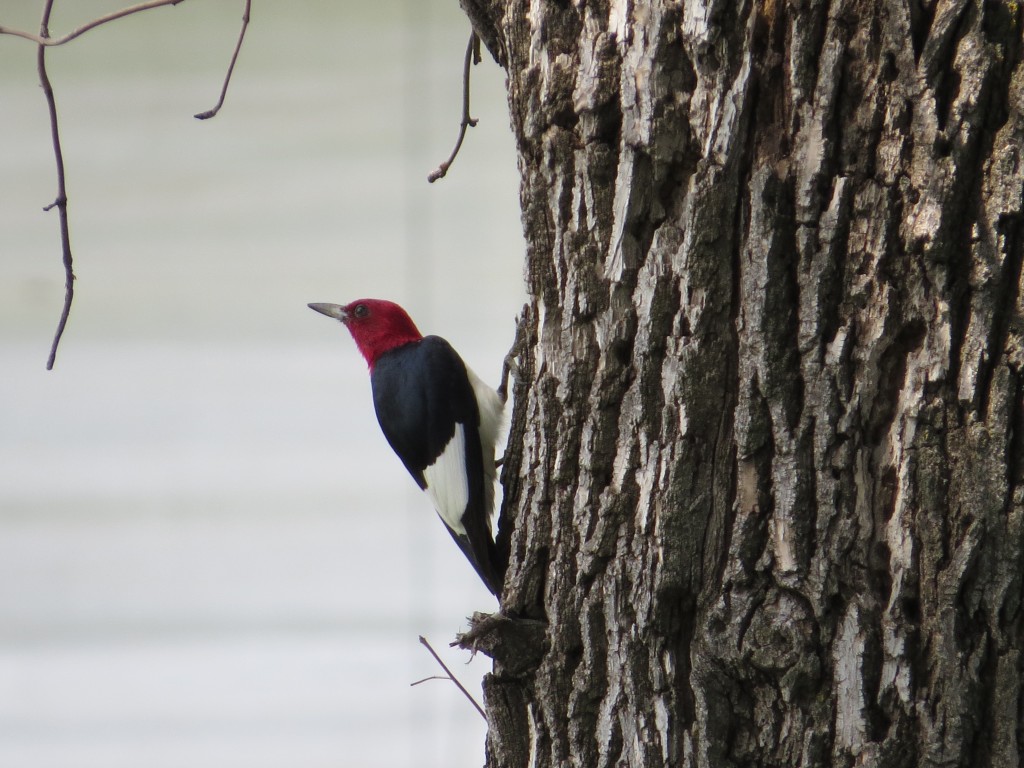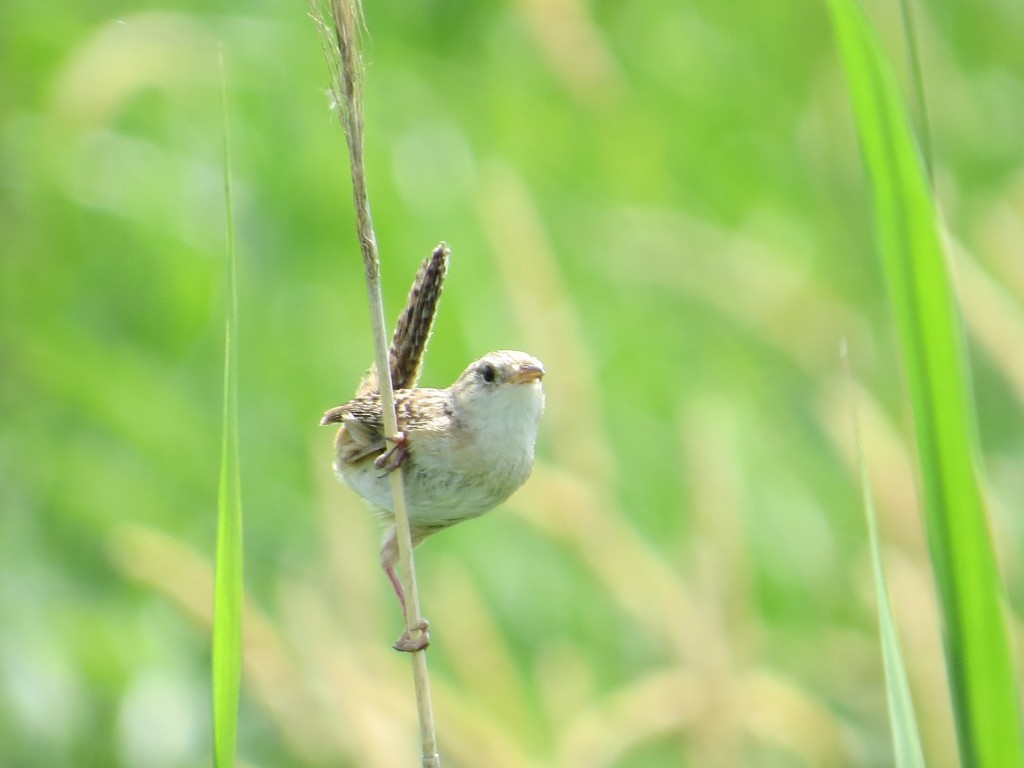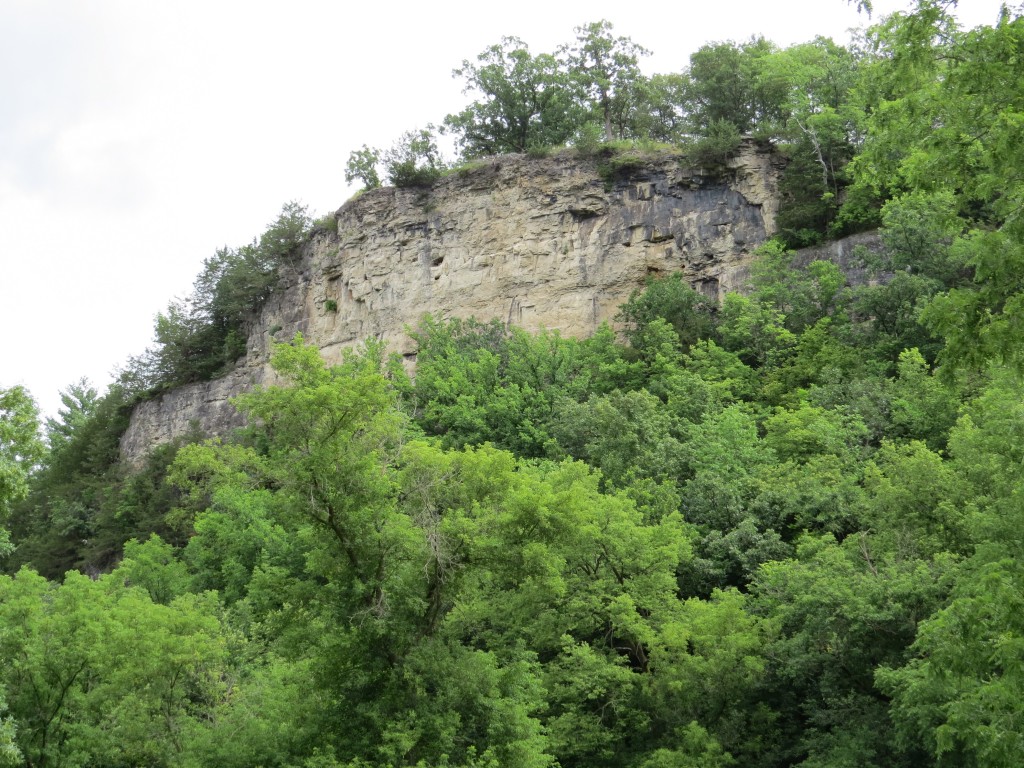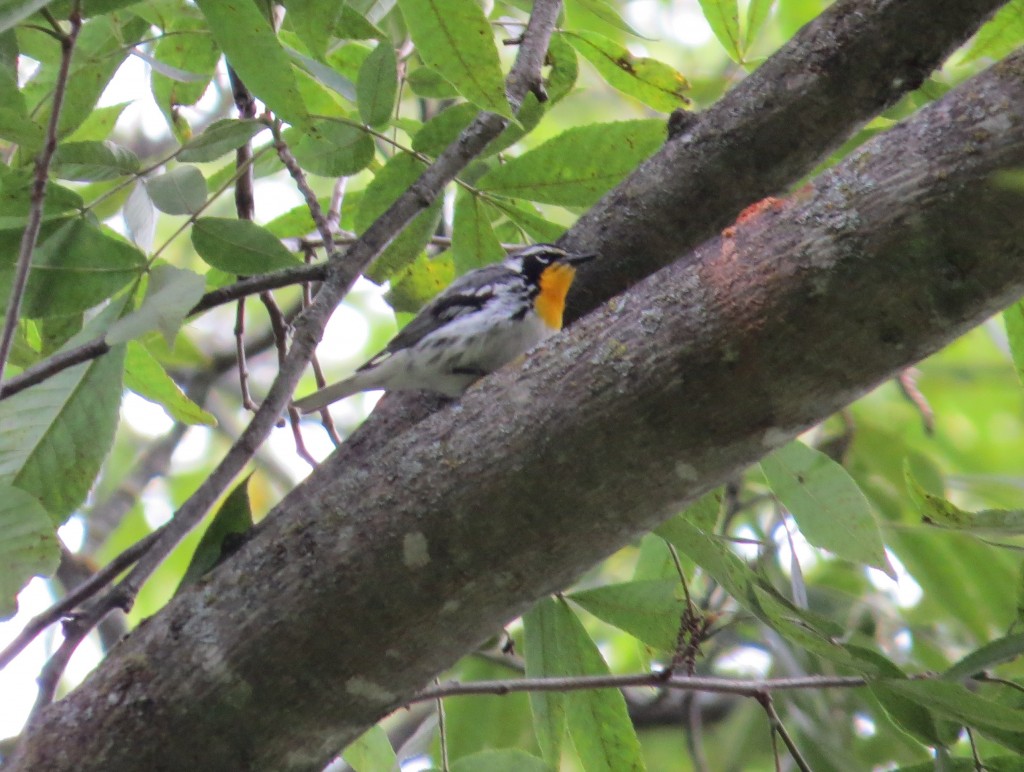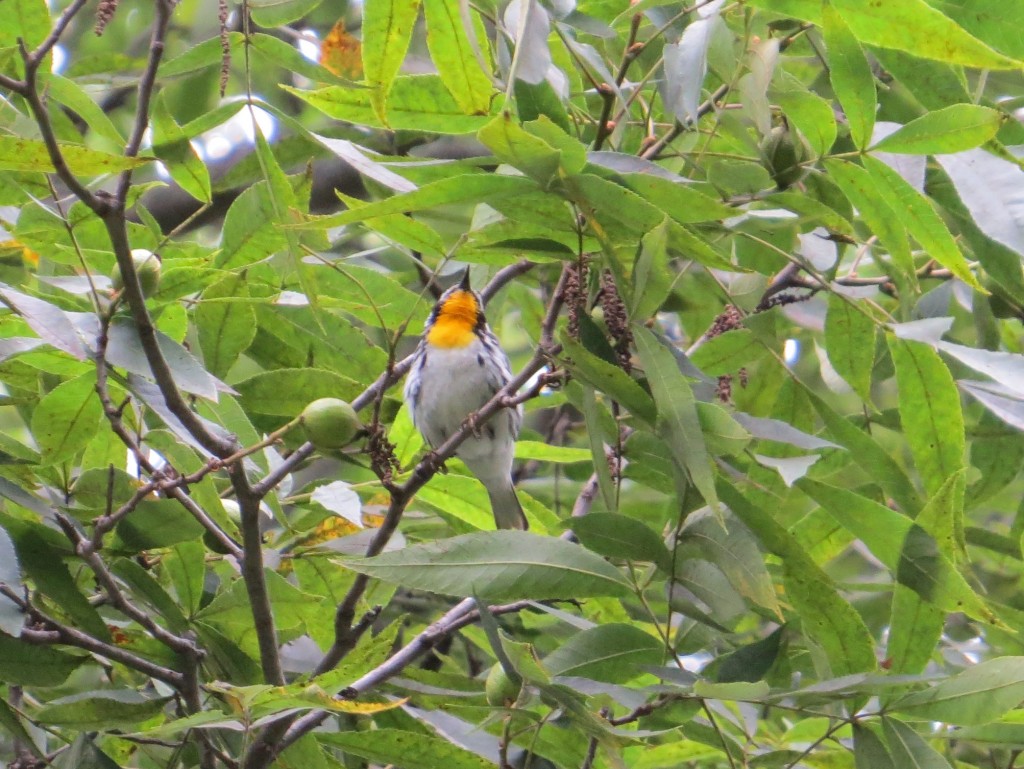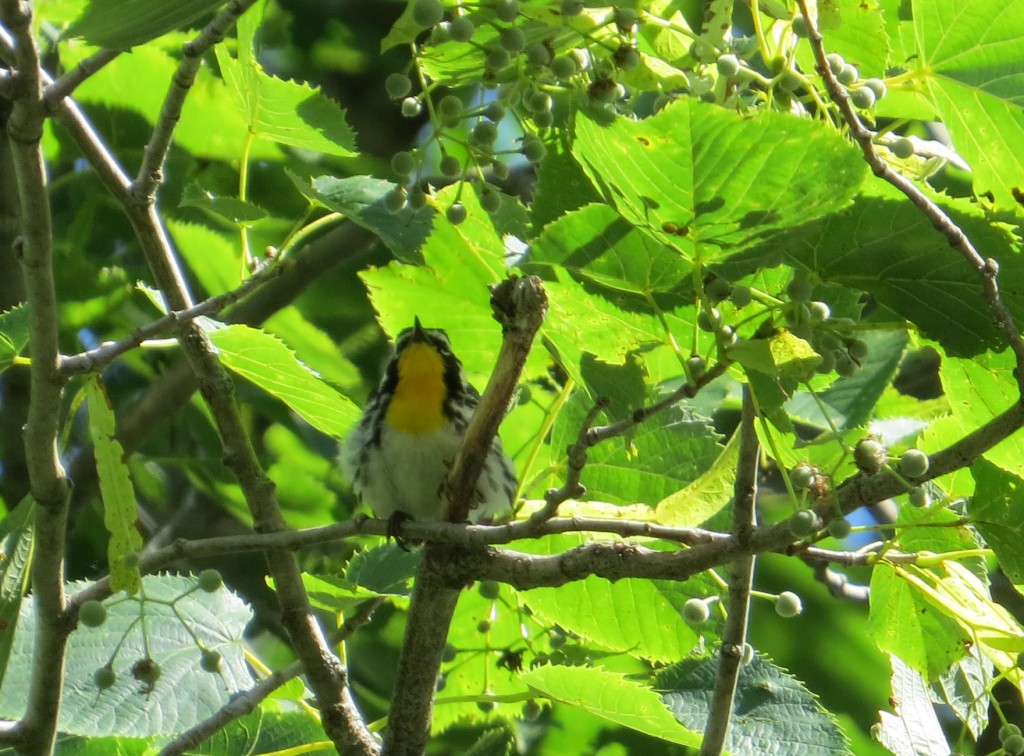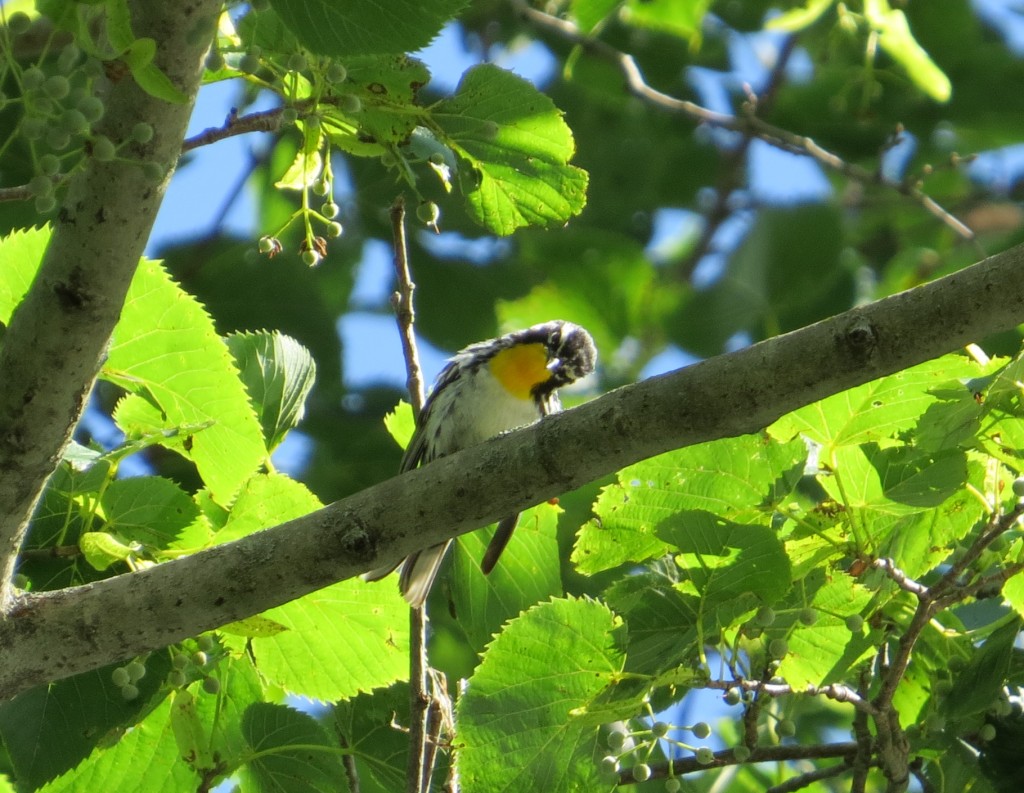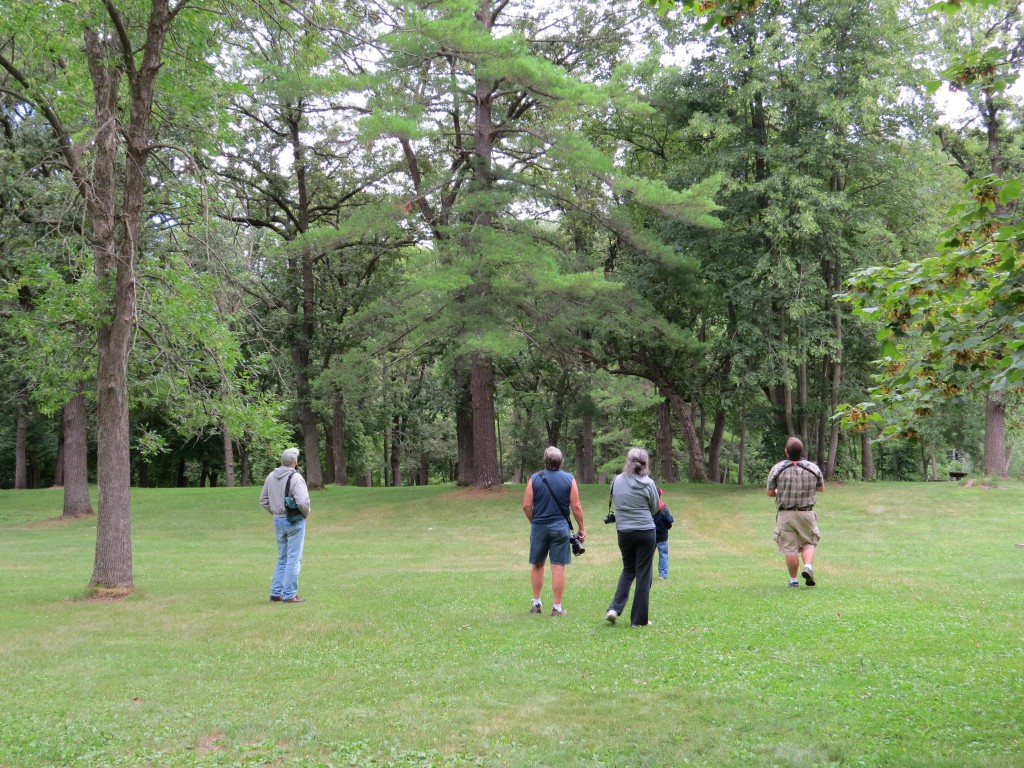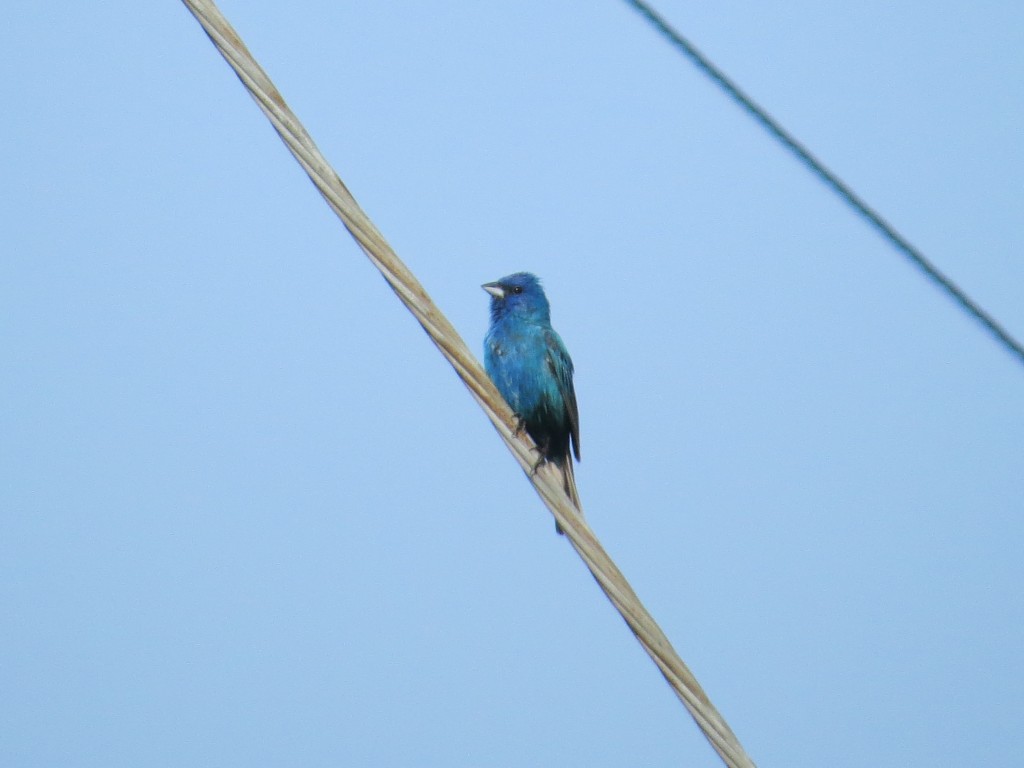Author Archives: Josh
198
The fun thing about birding is that birders are never not birding. A birder is very in tune with the sights and sounds around him and can easily find a target bird to go after and a place to go birding anywhere he goes. That was the case this weekend as we traveled to the Twin Cities to spend some time with my sister on her last day in the country before she and her family flew home to Nigeria. We stayed at a hotel in Brooklyn Park, which was near a reported location of the Western Kingbird in Ramsey. So, naturally we drove by the spot to see if we could find it. Birding on the busy, divided U.S. Highway 10 was scary. I think I pulled over once to look at a bird, but that was enough. We may have seen it, but we’ll never know. We’ll have to find that bird in a safer location.
Being in the northwest metro also put us near the Sherburne National Wildlife Refuge. I’ve seen many reports from here, so we decided to drive the Wildlife Tour Loop. I was hoping for an Eastern Towhee and maybe even a Henslow’s Sparrow. It was a beautiful drive in this completely undeveloped land, but we didn’t see any new birds.
We continued our travels home, and I held out hope for a Western Kingbird on Hwy. 10 in a couple different spots where they’d been reported. We still didn’t find any. So much for good incidental birding on this trip. But then I remembered all the poop ponds and flooded ditchs by Paynesville – we might still have a shot at something! I pulled off the highway and got out to look at one of the ponds that looked ripe for shorebirds with its exposed mudflats. I scanned the landscape for anything different. It didn’t take long to pick out some small brown shorebirds that looked promising. I didn’t know what they were, so I took lots of pictures to help with the ID when we got home. I was right that this was a new one for us – the Pectoral Sandpiper!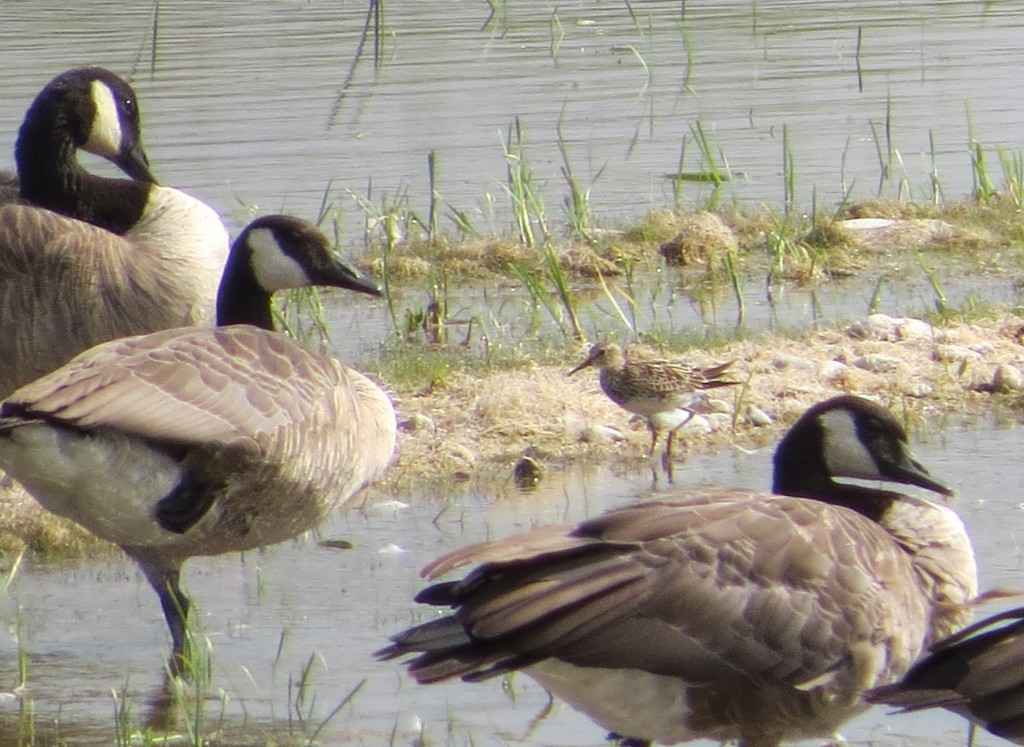 There were about ten of them scurrying about with a couple Killdeer mixed in.
There were about ten of them scurrying about with a couple Killdeer mixed in.
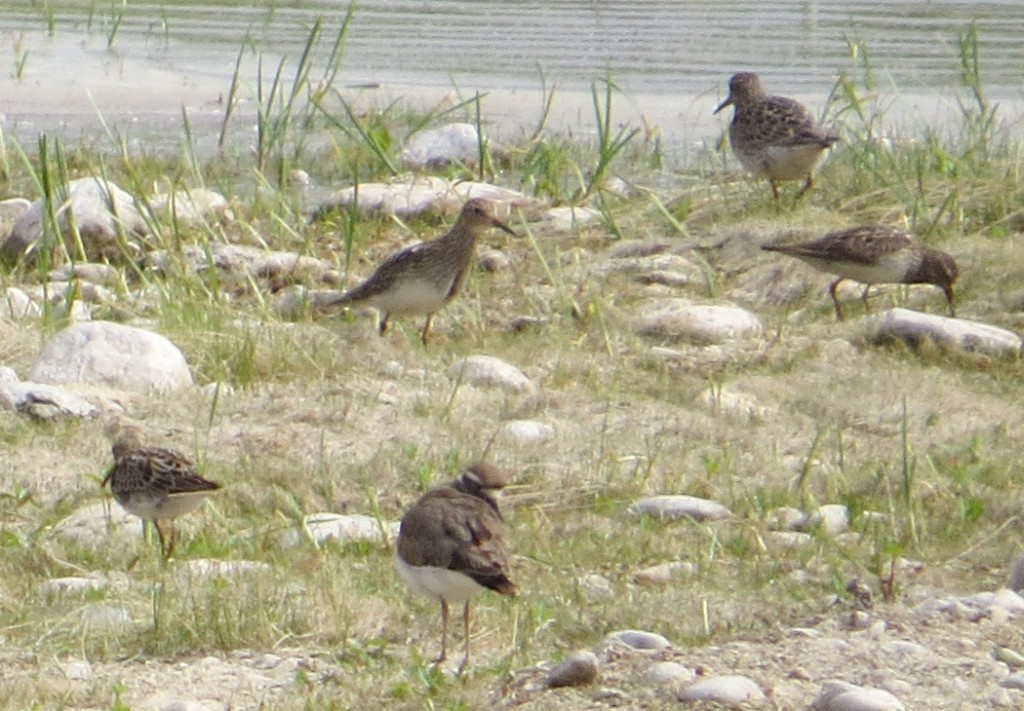 Two birds are all that stand in the way to the monumental 200 for Evan. Keep watching to see what they are and who’s going to win the Kaufman field guide!
Two birds are all that stand in the way to the monumental 200 for Evan. Keep watching to see what they are and who’s going to win the Kaufman field guide!
Red-necked Phalarope
Poop Ponds Produce…
…not #2, but lifer #197 for Evan. This evening I took the kids out to see if anything was happening on the Atwater sewage treatment ponds. Believe it or not, but birds and birders flock to sewage ponds. Right now fall shorebird migration is starting, and these are some of the best places to check for new migrants.
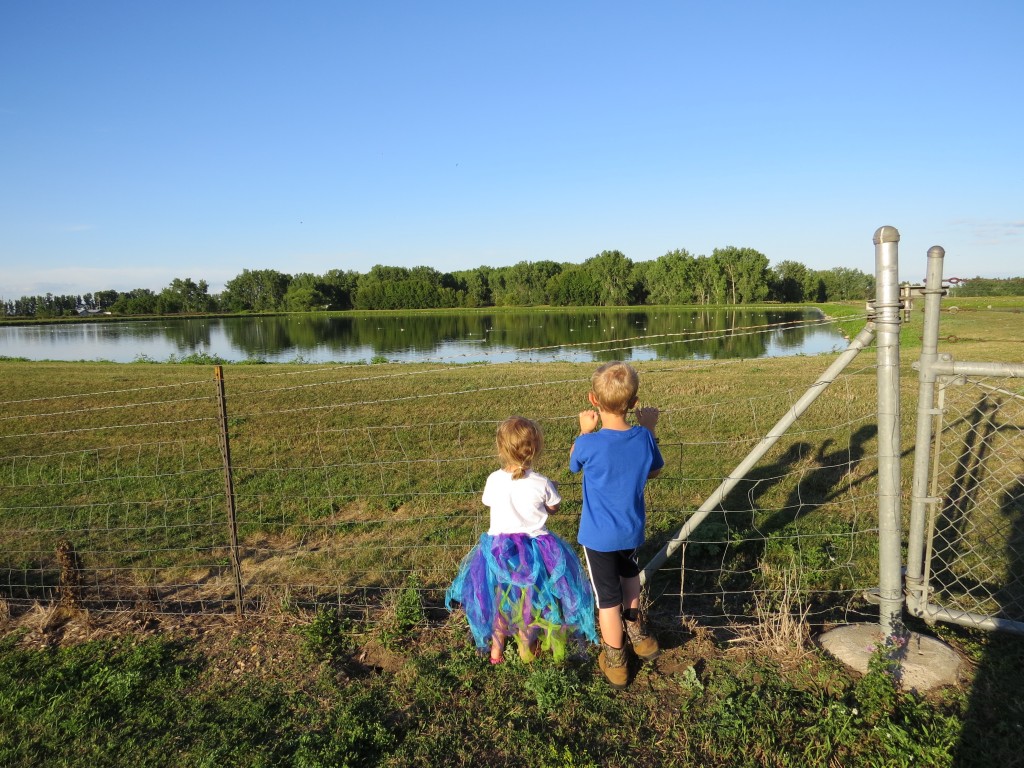 While we were there we saw dozens of Canada Geese and several Mallards. It was fun to see Franklin’s Gulls – they are the ones with the black heads. I had never seen such a gull or knew one existed until this past spring. I think they’re pretty neat.
While we were there we saw dozens of Canada Geese and several Mallards. It was fun to see Franklin’s Gulls – they are the ones with the black heads. I had never seen such a gull or knew one existed until this past spring. I think they’re pretty neat.
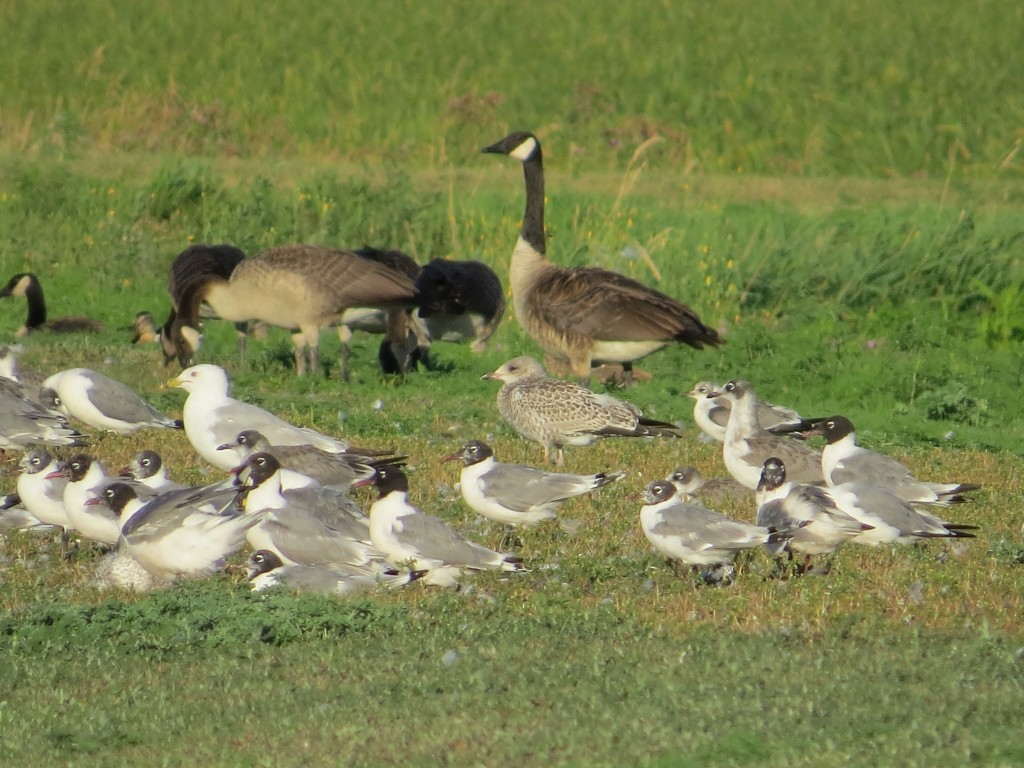 There were lots of immature gulls, but I found one nice mature one to photgraph.
There were lots of immature gulls, but I found one nice mature one to photgraph.
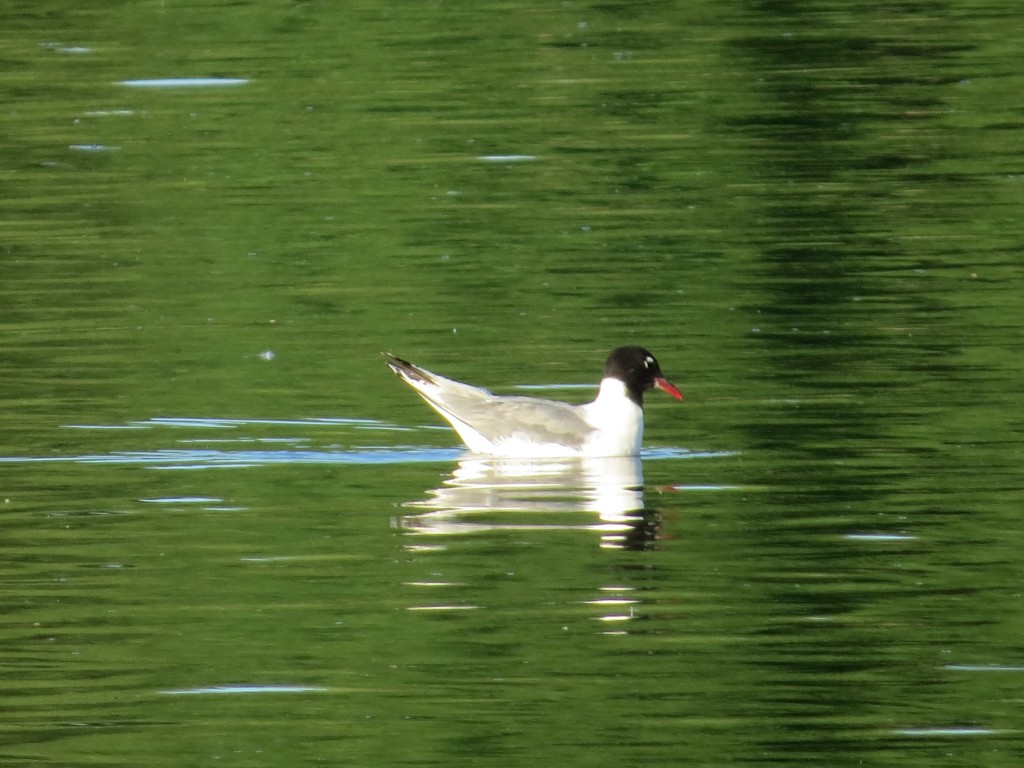 Despite all the activity on the water, I wasn’t seeing anything new until I spotted a small bird moving quickly back and forth through the water. It looked like a phalarope, but I wasn’t sure. Shorebirds can look a lot different during fall migration than spring migration. I took lots of photos to study later.
Despite all the activity on the water, I wasn’t seeing anything new until I spotted a small bird moving quickly back and forth through the water. It looked like a phalarope, but I wasn’t sure. Shorebirds can look a lot different during fall migration than spring migration. I took lots of photos to study later.
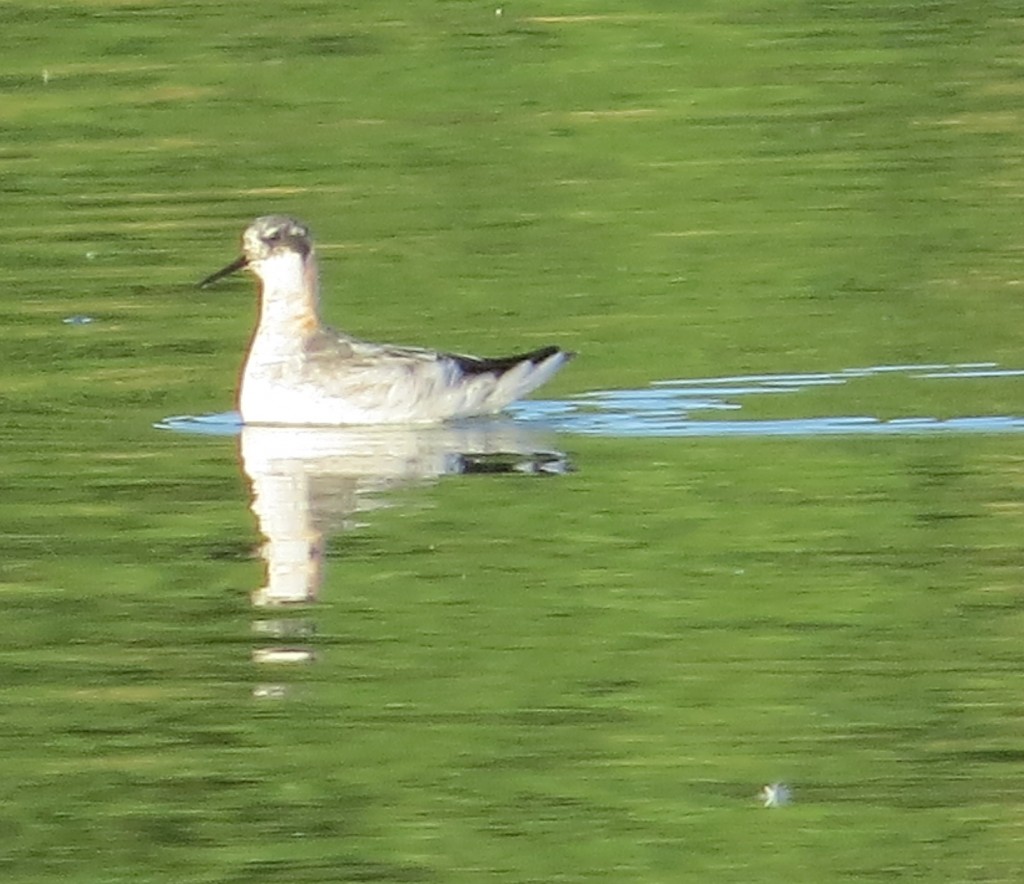 I thought I had the Wilson’s Phalarope, a bird that Evan needed but I did not. However, after studying the field guide and my pictures when we got home, I knew I was dealing with either a Red-necked Phalarope or a Red Phalarope. The latter would be very rare. The former was more probable. Either way, it was exciting to get a life bird for both Evan and me. The following photo helped me conclude it was, in fact, the Red-necked Phalarope.
I thought I had the Wilson’s Phalarope, a bird that Evan needed but I did not. However, after studying the field guide and my pictures when we got home, I knew I was dealing with either a Red-necked Phalarope or a Red Phalarope. The latter would be very rare. The former was more probable. Either way, it was exciting to get a life bird for both Evan and me. The following photo helped me conclude it was, in fact, the Red-necked Phalarope.
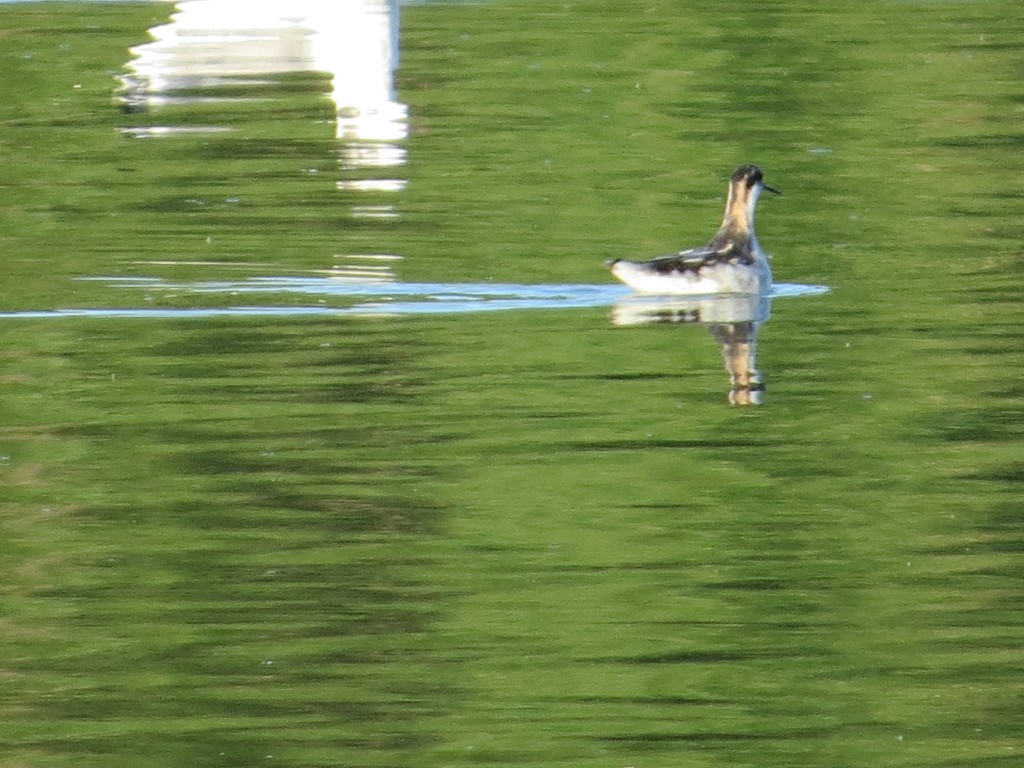 This wasn’t the only birding we did today. We started our day in search of the two cuckoo species that inhabit our area. I invited my friend Jeff and his two kids along as his family has taken quite an interest in birding. It was fun to show them birds that were common to us but new to them. Jeff got quite a kick out of me calling in not one, but three Sedge Wrens. One wren was quite agitated at us. We just saw this one for the first time ourselves yesterday.
This wasn’t the only birding we did today. We started our day in search of the two cuckoo species that inhabit our area. I invited my friend Jeff and his two kids along as his family has taken quite an interest in birding. It was fun to show them birds that were common to us but new to them. Jeff got quite a kick out of me calling in not one, but three Sedge Wrens. One wren was quite agitated at us. We just saw this one for the first time ourselves yesterday.
We did not find our cuckoos, though we did hear one. It was a fun time regardless as we watched Northern Cardinals, Eastern Kingbirds, Cedar Waxwings, Common Yellowthroats, American Kestrels, Purple Martins, American Goldfinches, Eastern Wood Pewees, Baltimore Orioles, and Black-capped Chickadees. It kind of amazed me how many birds have started to just blend into the background for Evan and me. We get so focused on finding the new bird, that we often miss all the cool stuff that’s around us. It was a refreshing birding experience. I had so much fun pointing out birds to Jeff and his kids and watching the birds myself that I didn’t really take many pictures. It was just good to be out in nature with some good friends.
Marsh Wren
Sedge Wren
The Push for 200 – A Two-Lifer Day
Spring migration has been long gone. Summer specialties that put us on the road have dried up. To make the final push for 200, we knew we’d have to grind it out, bird by bird. That means one thing – going after LBBs (little brown birds) in our own part of the state that we still have never seen. It was time to make something happen. To get a good birding fix we had no choice but to go after our missing LBBs. And that’s what the kids and I did today while their mother was on a shopping trip to the Cities.
We started by going to a Waterfowl Production Area to look for shorebirds. We saw some, but nothing was close and we couldn’t make out positive IDs. So we moved on to the location of an Upland Sandpiper, a bird Evan still needed. We struck out there, too. As we traveled down dusty roads, though, I drove slow with the windows open, listening for a new bird. Things sure are quiet out there now as most birds are no longer singing as they are either taking care of young or beginning to head south already. Then I heard a song that made me hit the brakes. It sounded like a wren we still needed, either the Sedge Wren or Marsh Wren. I played the Sedge Wren song on the iPod – it was a spot-on match for what we were hearing.
Now the trick was to see the bugger. It was in a short grass meadow between two cattail marshes, exactly the type of habitat the field guide described. Joel told me that in order to see one, I should walk in the direction of the sound. He said a bird on territory will get agitated and present itself. There was a problem, though. I had two curious farmers watching my every move from down the road. I wasn’t about to step onto private land. Finally I gave up, and we moved along. It was frustrating to know a life bird was singing right next to us, but we couldn’t see it.
Since we were near the location where I discovered a Red-headed Woodpecker a couple weeks ago, I decided to swing by to see if we could see it again. They are incredible birds. Instantly we saw it. And then another. And another. There was one, maybe two families of these woodpeckers. This was great news! These birds are in decline, so it was thrilling to find multiple adults and juveniles with them.
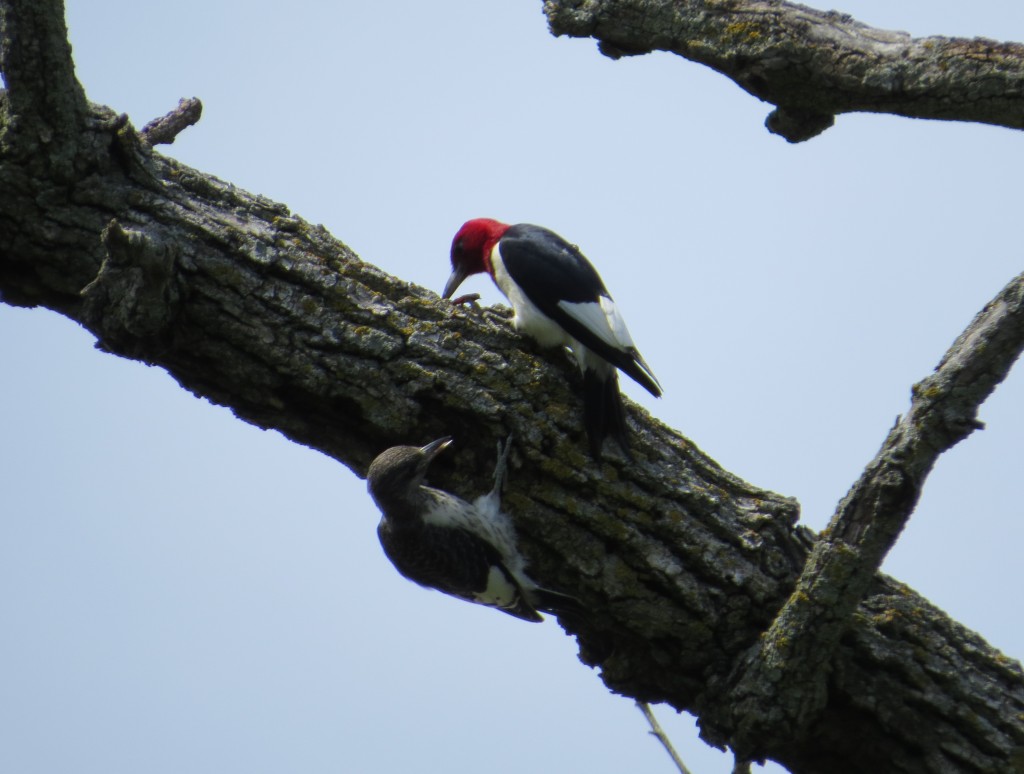 The kids entertained themselves in the car by drawing and coloring. Here is Evan’s rendition of the woodpecker that he drew while I took pictures.
The kids entertained themselves in the car by drawing and coloring. Here is Evan’s rendition of the woodpecker that he drew while I took pictures.
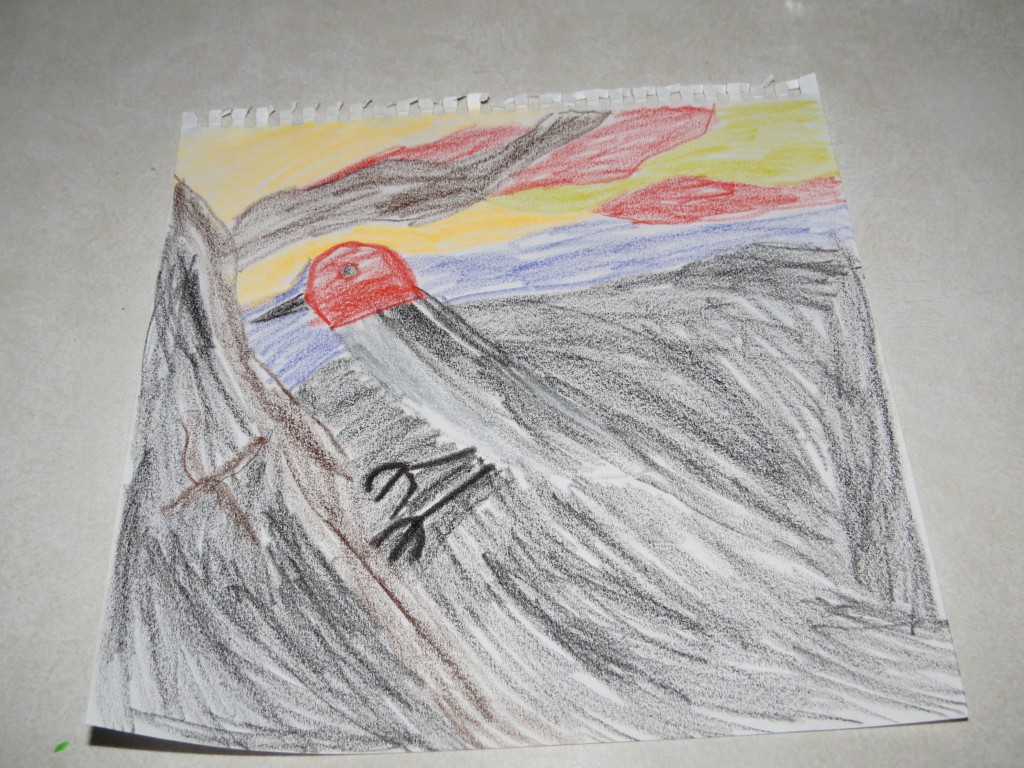 After getting our fill of the Red-headed Woodpeckers (which is tough to do!), we went back to the Sedge Wren spot. No farmers watching us this time. I still didn’t want to trespass, though. I decided to play the bird’s song on my phone. Instantly the little brown bird we were after came buzzing up to the road to investigate. Evan hopped out of the van to get a good look for himself.
After getting our fill of the Red-headed Woodpeckers (which is tough to do!), we went back to the Sedge Wren spot. No farmers watching us this time. I still didn’t want to trespass, though. I decided to play the bird’s song on my phone. Instantly the little brown bird we were after came buzzing up to the road to investigate. Evan hopped out of the van to get a good look for himself.
Not to be outdone on his own turf, he started singing back to us.
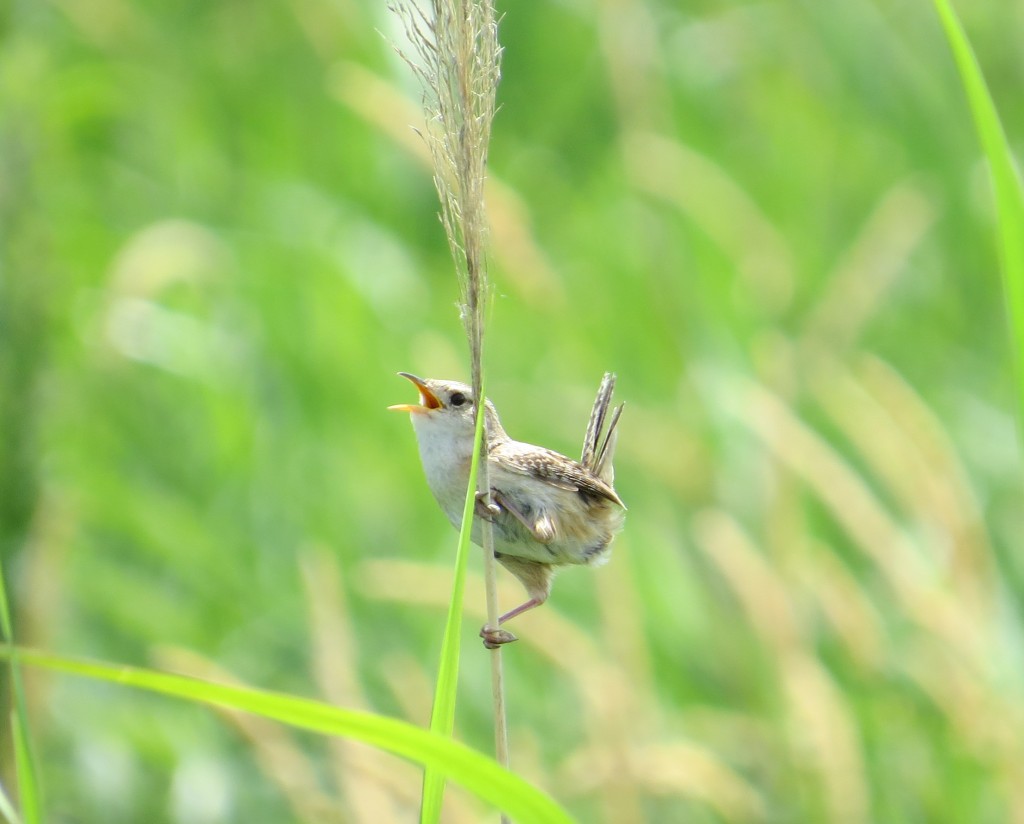 Then he was like, “Wait a minute, something isn’t right.”
Then he was like, “Wait a minute, something isn’t right.”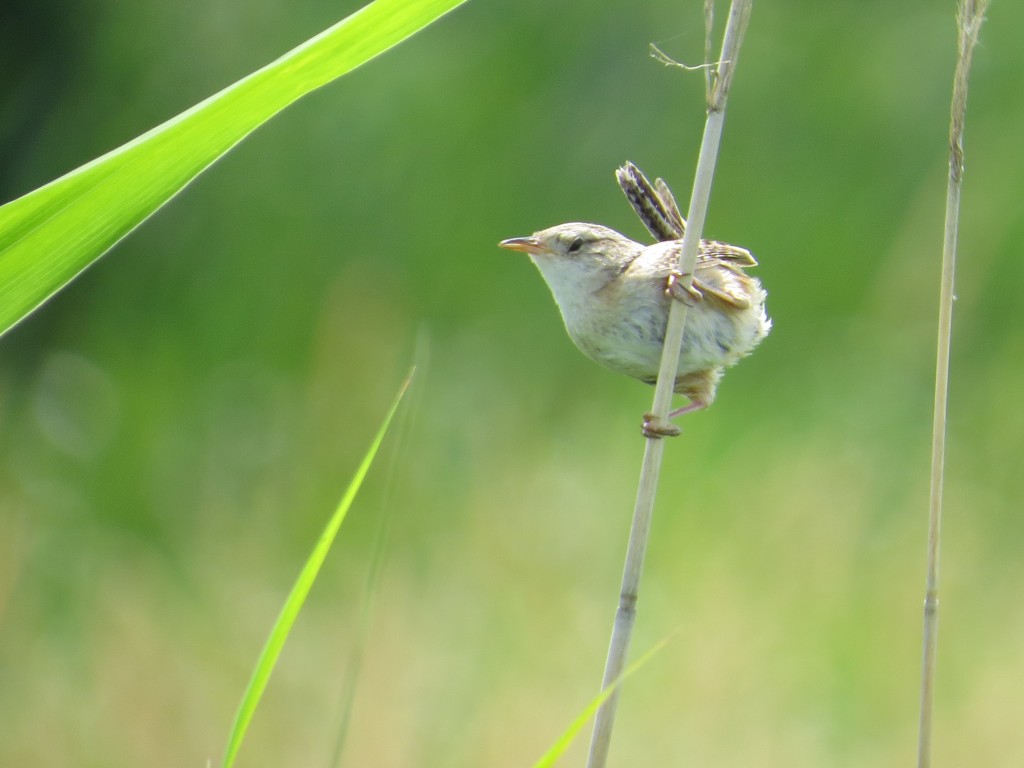 Then he showed us the “moon.”
Then he showed us the “moon.”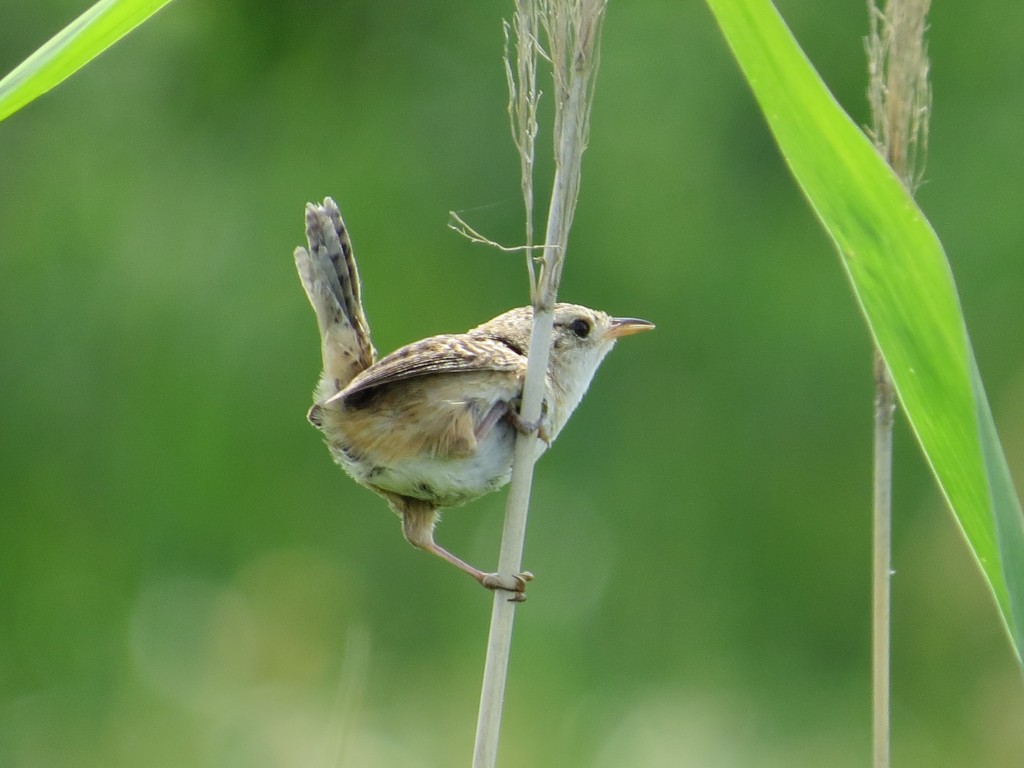 Back into the short grass. Can you find him?
Back into the short grass. Can you find him?
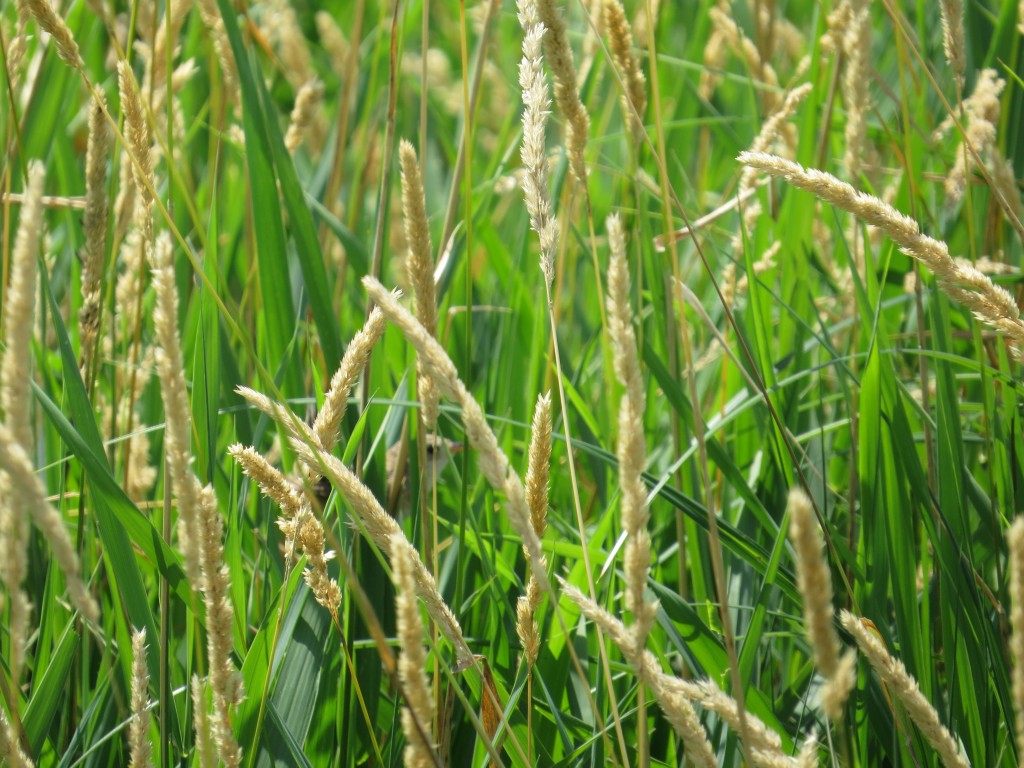 As fun as it was to get this life bird, it was time to leave. The kids were anxious for some promised ice cream in town. After the ice cream and some errands, we were back at home. I was sorting through my most recent pictures when I got an email from Randy. He wanted to take us out birding tonight! You don’t say no when Randy offers. We already had a good day getting a lifer. Now we were about to go out with the local expert. Even Evan knew this was a special outing, so he put on all his birding gear: hat, vest, binoculars, khaki pants, and hiking boots. Randy asked us what our targets were. One was the Marsh Wren. So that’s what we went after first. We also looked for shorebirds as fall migration has started already if you can believe that.
As fun as it was to get this life bird, it was time to leave. The kids were anxious for some promised ice cream in town. After the ice cream and some errands, we were back at home. I was sorting through my most recent pictures when I got an email from Randy. He wanted to take us out birding tonight! You don’t say no when Randy offers. We already had a good day getting a lifer. Now we were about to go out with the local expert. Even Evan knew this was a special outing, so he put on all his birding gear: hat, vest, binoculars, khaki pants, and hiking boots. Randy asked us what our targets were. One was the Marsh Wren. So that’s what we went after first. We also looked for shorebirds as fall migration has started already if you can believe that.
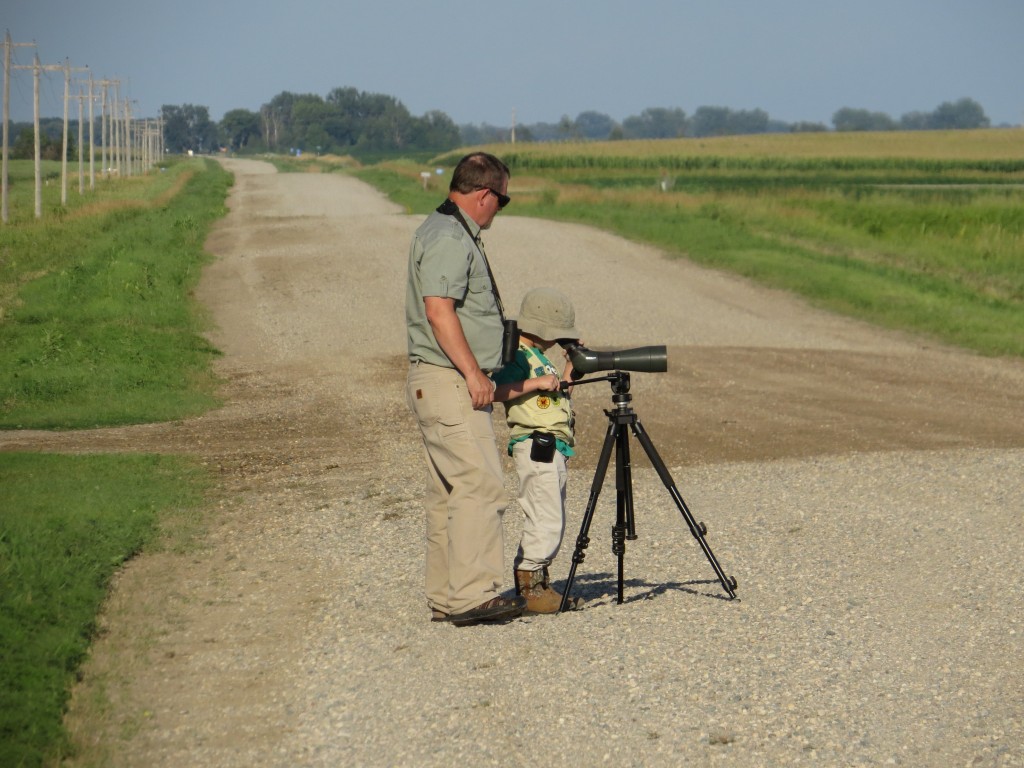 The Marsh Wren was not showing at any of the large cattail marshes we stopped by. Randy had said it’s an easy bird to hear and see. It was dead calm everywhere. Not a one could be heard. Nothing came to the playback of the song on my phone. Bizarre. Maybe it was too late in the season for them to care about another singing wren and defend their territory. We maybe saw one flit here or there, but we made no positive ID.
The Marsh Wren was not showing at any of the large cattail marshes we stopped by. Randy had said it’s an easy bird to hear and see. It was dead calm everywhere. Not a one could be heard. Nothing came to the playback of the song on my phone. Bizarre. Maybe it was too late in the season for them to care about another singing wren and defend their territory. We maybe saw one flit here or there, but we made no positive ID.
Finally, though, Randy spotted one that wasn’t singing. It was only chipping in the cattails.
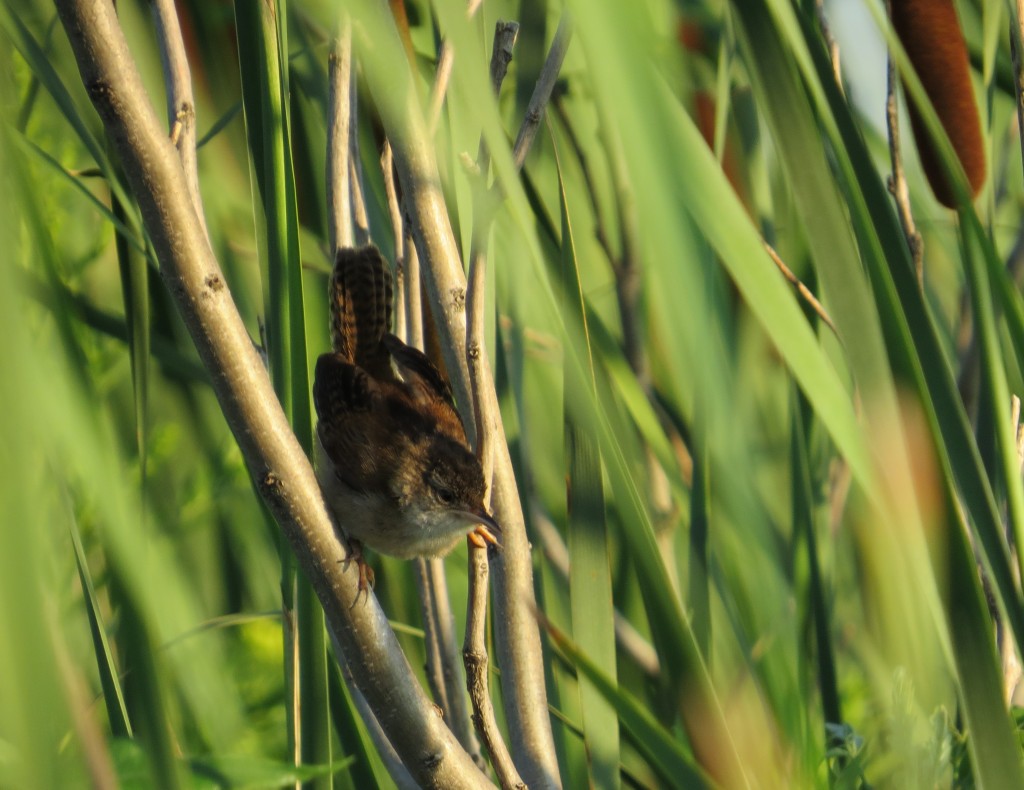 You can see the resemblance to the Sedge Wren, except this bird was much darker. I thought it was really neat how these birds are built to live in the cattails. Check out the way it holds itself up.
You can see the resemblance to the Sedge Wren, except this bird was much darker. I thought it was really neat how these birds are built to live in the cattails. Check out the way it holds itself up.
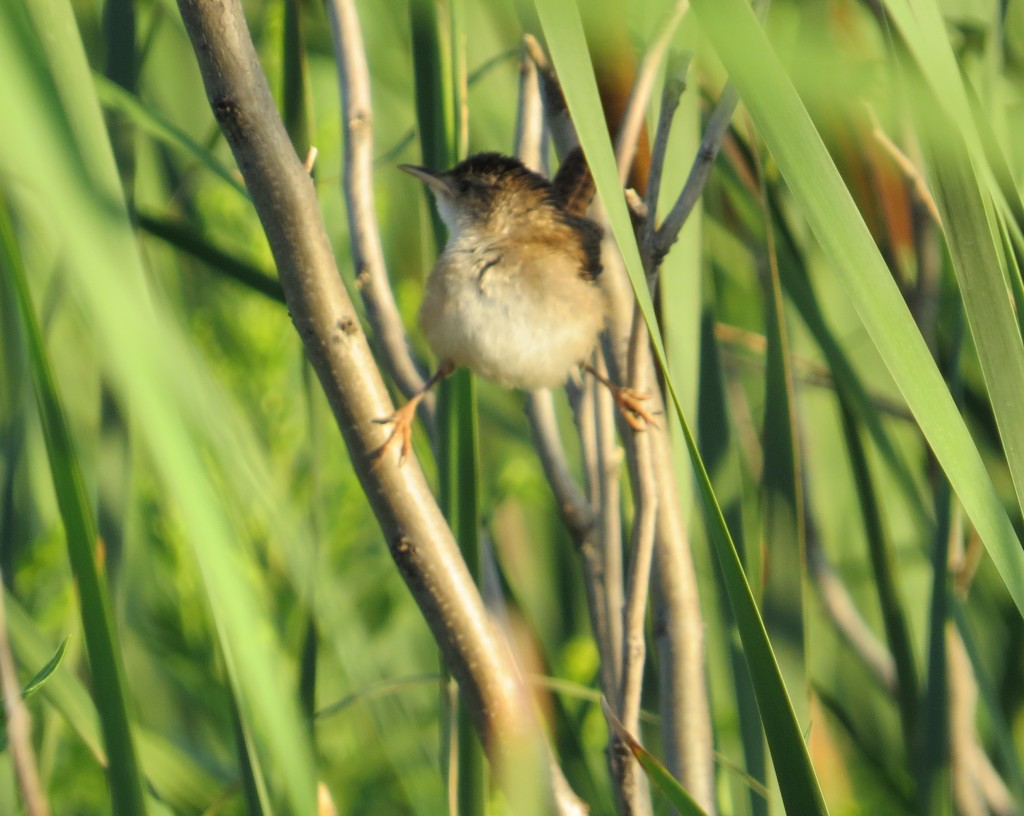 A two-wren day! A two-lifer day! Evan now sits at 196 species. The noose is tightening on 200. Will they all come in one day, or will it be a drawn-out battle to get them one at a time?
A two-wren day! A two-lifer day! Evan now sits at 196 species. The noose is tightening on 200. Will they all come in one day, or will it be a drawn-out battle to get them one at a time?
Yellow-throated Warbler
The Whitewater State Park Trifecta – a Rare Bird, an Old Friend, and a Patch
 It is really quite crazy how certain events can unfold and line up to create a birding trip that seemed as if it was destined to happen. That was the case on this most recent one-night adventure that Evan and I took to yet another state park. While it may appear we fly out of the driveway and head off to a distant land for any old bird, that simply isn’t true. If it was, we would be on the road every day because there are a lot of birds in Minnesota that we haven’t yet seen. But I recognized this latest chase as being a very rare opportunity that in all probability would not happen again.
It is really quite crazy how certain events can unfold and line up to create a birding trip that seemed as if it was destined to happen. That was the case on this most recent one-night adventure that Evan and I took to yet another state park. While it may appear we fly out of the driveway and head off to a distant land for any old bird, that simply isn’t true. If it was, we would be on the road every day because there are a lot of birds in Minnesota that we haven’t yet seen. But I recognized this latest chase as being a very rare opportunity that in all probability would not happen again.
Before I go into the details of the chase, it’s important to build the background for this latest story. It started 14 years ago at the University of Minnesota-Morris when I met Malcolm – someone who shared my enthusiasm for mathematics and a different sort of birding. Malcolm and I were both avid waterfowl and upland game hunters who quickly found ourselves sharing a jeep or a canoe as we hunted the birds of the prairie pothole region of western Minnesota. Though we became roommates, we eventually lost track of each other after college. That changed this winter when I posted a bird photo to a Facebook birding page asking for identification help. One of the people who commented was Malcolm! We reconnected online and mutually discovered we had both gotten into birding in recent years. It was a fun discovery.
On one of our first bird chases, when we went after the Painted Bunting in Aitkin, I ended up searching for the bunting right alongside some of Malcolm’s birding companions. As we corresponded about the small world of birding and the sport of chasing, Malcolm planted a seed in my mind when he said there was a Yellow-throated Warbler taking up residence by the Nature Store at Whitewater State Park. He said if we felt like chasing it, we were welcome to stay at his house which was only a half hour away from there. At the time, I didn’t know a Yellow-throated Warbler from the dozens of other warblers I hadn’t yet seen. I think I had only seen a few warblers by that point. I didn’t realize that the Yellow-throated Warbler is a special find in Minnesota; this bird’s range is in the southeastern part of the country. They are rare strays here. In fact, this particular bird was a first for Winona County.
As spring and summer rolled on, we had racked up the warblers. Last time I checked, our warbler list grew from just a few species to 26. Any regular reader knows that warblers are the birds I enjoy most. With each new warbler found, the desire for the rare warblers increased – hence the trip to Oberg Mountain for the Black-throated Blue Warbler or the trip to Lyon County for the Cerulean Warbler. Now I was eyeing up this Yellow-throated Warbler and trying to find a way to justify another bird trip to see it. After all, it was four hours away to Whitewater State Park. I tempted myself to go on this trip by emailing Malcolm to find out if that bird was even still present. Malcolm responded that he hadn’t checked for over a month, but he showed me how I could query the MOU database to look up other birders’ reports of sightings to find my answer. I also learned through our correspondence that he was moving to Kansas City in mid-August. The window for going birding with an old friend was closing fast. Besides the fact that we had a limited time to meet up with Malcolm, we also had to worry if the bird was still around. Then, if it was, we had to consider that the warbler would be heading south soon as fall migration starts near the end of summer for this species. I discovered from my queries, though, that this warbler had, in fact, been consistently active all summer. It was there as recently as July 20. Many of the reports said it was right in the vicinity of the Nature Store and was singing loudly on territory and easy to find.
So the bird and birder were still there, but could we go? We’ve traveled a lot this summer and were scheduled for another trip the last week of July to Madeline Island with my family. At some point I had to start restricting myself. But then a turn of events made the Whitewater trip more probable. Marin’s Hand, Foot, and Mouth Disease forced us to cancel our trip to Madeline Island. Now there was a little more freedom with time and money to be able to go after the Yellow-throated Warbler. After Marin started recovering, I became ill for a couple days. By this time I was wondering if we were too late for the warbler. The end of July is getting really late to find them as they typically don’t sing as much on territory since they are busy taking care of their young. If you can’t hear a bird this time of year, chances are you won’t find it. But then I got a welcome email from MOU-Net on July 25th in which a person reported that the bird was still there singing loudly. It was go time.
Not only were we going after a rare warbler for Minnesota and seeing an old friend, but we were headed to another state park. This means one thing for Evan: a new patch for his ruck sack. On the day I decided to head off to the southeastern corner of the state, I called Whitewater to find out if they had any camp sites available. I knew it was an extremely popular park, so I was worried. It turns out they only had three left out of nearly 70. Our plan to leave after lunch was moved up to 10:00 AM. The decision to go was made so fast that I only emailed Malcolm to tell him what we were doing. I didn’t know if he would be able to join us, but I hoped it worked in his schedule. En route he replied to me saying he would like to go birding with us and could even help us find some of our secondary targets that were southeastern Minnesota specialties.
Once we got near Rochester, I called the park again – no vacancies! No! I anticipated this, so I went to plan B which was Carley State Park – a non-descript state park 8 miles from Whitewater. From touring it 10 years ago with Melissa, I knew this place wasn’t somewhere I wanted to camp. Because that’s all it is, a place to camp. There is nothing special about the park unless you want to play Bocce Ball or Croquet on its one picnic ground area. Whether we liked it or not, we had to race to get there because Carley only had four sites open. Thankfully there were a couple still open by the time we arrived.
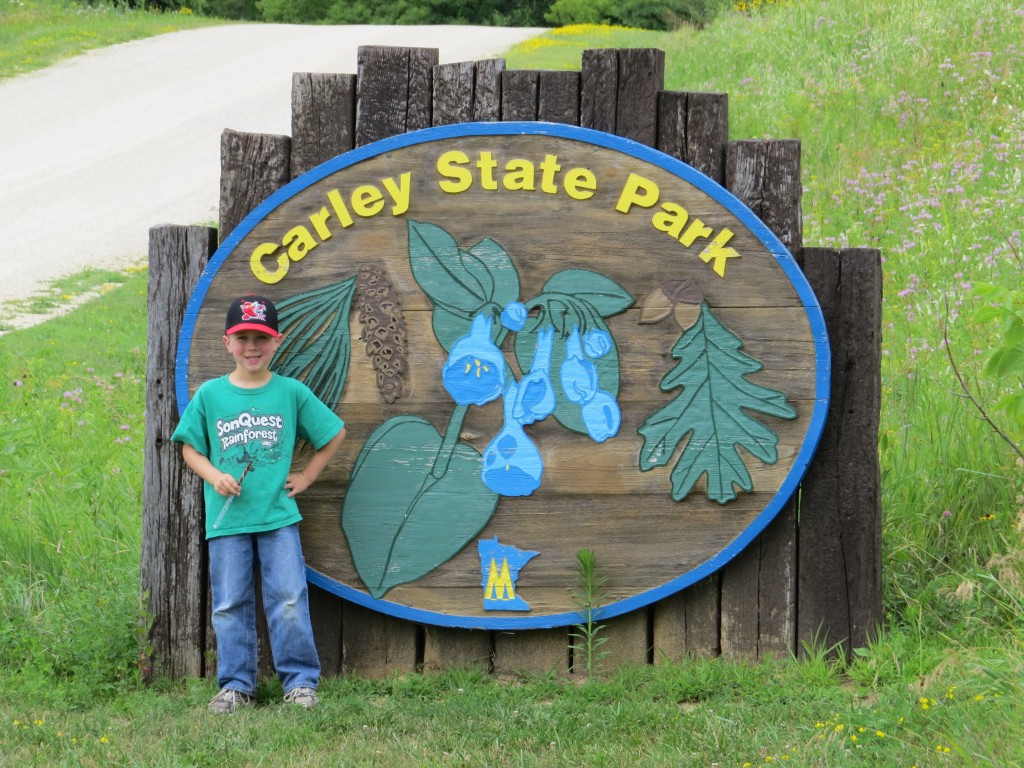 This created a patch dilemma since our rule is that we have to spend the night at a park for Evan to earn that park’s patch. I was hoping it would be the Whitewater patch since that’s where our target bird was. I consulted Melissa, and we concurred. We’d override our rule and make it a two-patch trip. After all, Whitewater was where we were birding, and I know we will go back and camp there someday. The beauty of these bluff lands is amazing. The park is nestled at the bottom of the Whitewater River valley surrounded by very large bluffs or mini-mountains. The Whitewater River runs right through the campground and has the feel of a mountain stream – complete with ice-cold, crystal-clear water and rainbow trout. You’ll forget you’re in Minnesota if you ever visit.
This created a patch dilemma since our rule is that we have to spend the night at a park for Evan to earn that park’s patch. I was hoping it would be the Whitewater patch since that’s where our target bird was. I consulted Melissa, and we concurred. We’d override our rule and make it a two-patch trip. After all, Whitewater was where we were birding, and I know we will go back and camp there someday. The beauty of these bluff lands is amazing. The park is nestled at the bottom of the Whitewater River valley surrounded by very large bluffs or mini-mountains. The Whitewater River runs right through the campground and has the feel of a mountain stream – complete with ice-cold, crystal-clear water and rainbow trout. You’ll forget you’re in Minnesota if you ever visit.
Once camp was set up, we went to Whitewater to check things out. We listened for the Yellow-throated Warbler at the Nature Store. Nothing. I was secretly hoping to check it off right away to take the pressure off. Well, morning is the best time to find any bird, so hope was not lost even if it was diminished a bit. We went back to Carley to have supper, work on Evan’s Park Naturalist workbook (something that when completed earns him a patch from the Minnesota State Parks system), play some cards, and go to bed.
We woke up early to get over to the Nature Store parking lot before our meeting time of 7 AM with Malcolm. I was hoping we’d hear our bird while we waited for Malcolm. Nothing again. Were we too late? Did the recent drop in daily temps force this southern bird to leave early?
Malcolm showed up on time, and it was a lot of fun to reconnect and visit while we looked for this target bird. After spending some time in the parking lot, we ambled over to the adjacent picnic grounds toward the river. There was still no sign of the bird. It was now becoming worrisome. After nearly an hour we decided to go after another warbler that Evan and I needed that was a reliable find at this park – the Louisiana Waterthrush. We hiked along a trail that had us go next to and criss-cross the Whitewater River which was more like a small creek the further upstream we went.
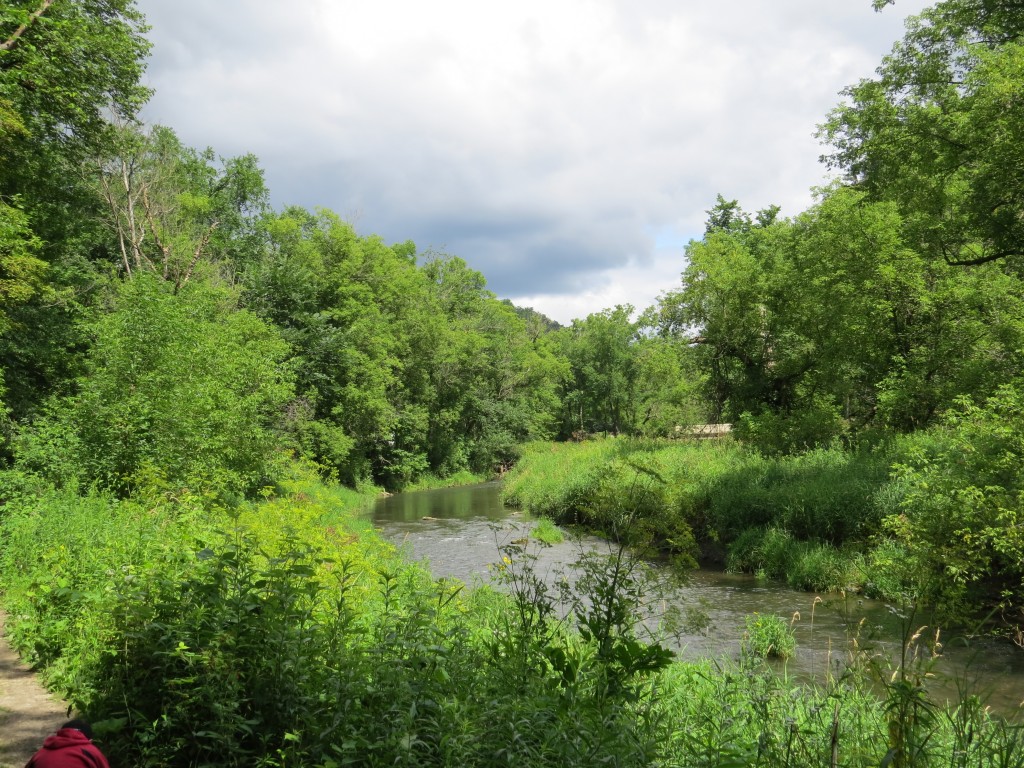
As Malcolm and I discussed careers, life, and birds, Evan would run ahead looking for trout in the stream and occasionally throw rocks. It was a pretty relaxed walk even though we were after a specific bird. We never did find our secondary target, though. Now we had struck out on two birds.
It was now time to head back to the parking lot to make another check for the Yellow-throated Warbler. Again there was no song. Malcolm said that when it sings it can be heard from a fair distance. In other words, if it was there we should hear it. We continued our visit as we waited and watched. At one point I consulted the latest MOU-posting from two days ago and picked up on a detail I missed. It said the bird was found around the parking lot and througout the adjacent picnic grounds. We hadn’t searched the picnic grounds much at all. It was worth a shot.
We headed that way, but Evan needed something back at the car. He and I went back while Malcolm searched. After that errand, we went to rejoin Malcolm. Evan was more interested in listening to Justin Bieber than listening for our bird.
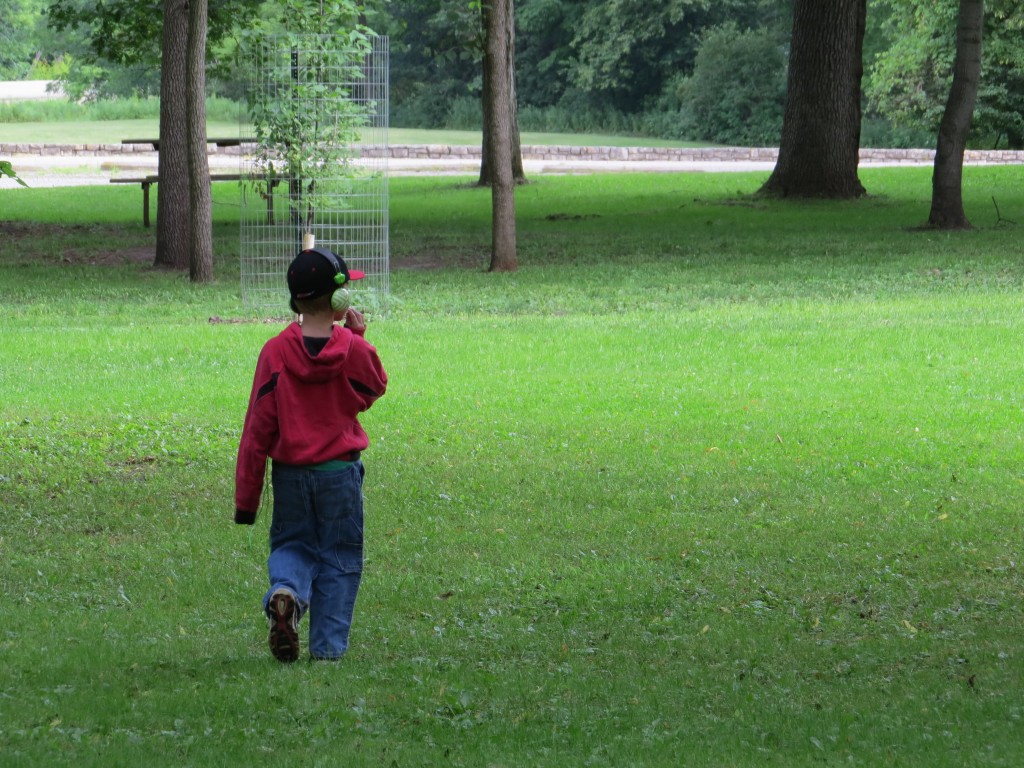 I no sooner took this photo then heard Malcolm holler my name. I could tell by the sound of his voice that he finally found it. Evan and I began to jog his way. Malcolm had, in fact, found the bird in a small white pine near the highway. Though he’s seen this bird before, he got his best view of it on a low branch. It normally hangs out in the tops of tall, tall white pines. It was a good thing we had Malcolm to guide us; otherwise we probably would have never located the bird.
I no sooner took this photo then heard Malcolm holler my name. I could tell by the sound of his voice that he finally found it. Evan and I began to jog his way. Malcolm had, in fact, found the bird in a small white pine near the highway. Though he’s seen this bird before, he got his best view of it on a low branch. It normally hangs out in the tops of tall, tall white pines. It was a good thing we had Malcolm to guide us; otherwise we probably would have never located the bird.
After a little bit of searching, we finally got our eyes on it too. The flash of that brilliant yellow throat was exhilarating. Now it was time to work on getting a good photo – something that clinches a target bird for me. As we watched and chased the bird from tree to tree, we saw that there were other warblers with it. Malcolm quickly got excited because it appeared they were juveniles with the parents. Up to this point, this male Yellow-throated Warbler was the only one observed. It alone was a record for the county, so a breeding pair would be big news.
Now we were keeping close track of these birds for different reasons. I wanted my picture, and Malcolm wanted proof that these were juveniles. We got many good views of the birds, and I was able to get some photos of the male.
Here is a picture of one of the juveniles we saw.
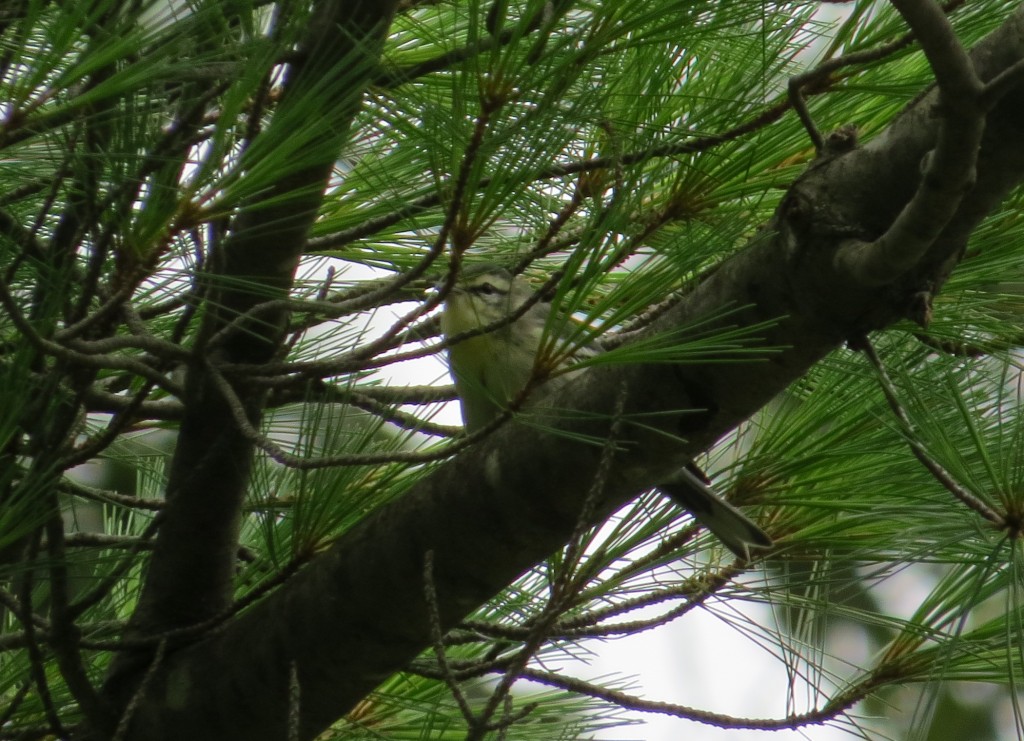 As we chased the Yellow-throated Warbler family around the picnic grounds, other birders started to join our ranks. Apparently they, too, wanted to view this special visitor before it was too late. It’s kind of funny because the faces are unfamiliar, but the names are not. Through our online birding, we frequently meet birders that we’ve heard of before.
As we chased the Yellow-throated Warbler family around the picnic grounds, other birders started to join our ranks. Apparently they, too, wanted to view this special visitor before it was too late. It’s kind of funny because the faces are unfamiliar, but the names are not. Through our online birding, we frequently meet birders that we’ve heard of before.
Here is a picture of a funny moment that occurred while Malcolm sought his evidence. Malcolm excitedly claimed to hear a second male Yellow-throated Warbler and pointed in the direction of the sound. But it was not a bird. It turned out to be Evan playing the bird’s song on his iPod.
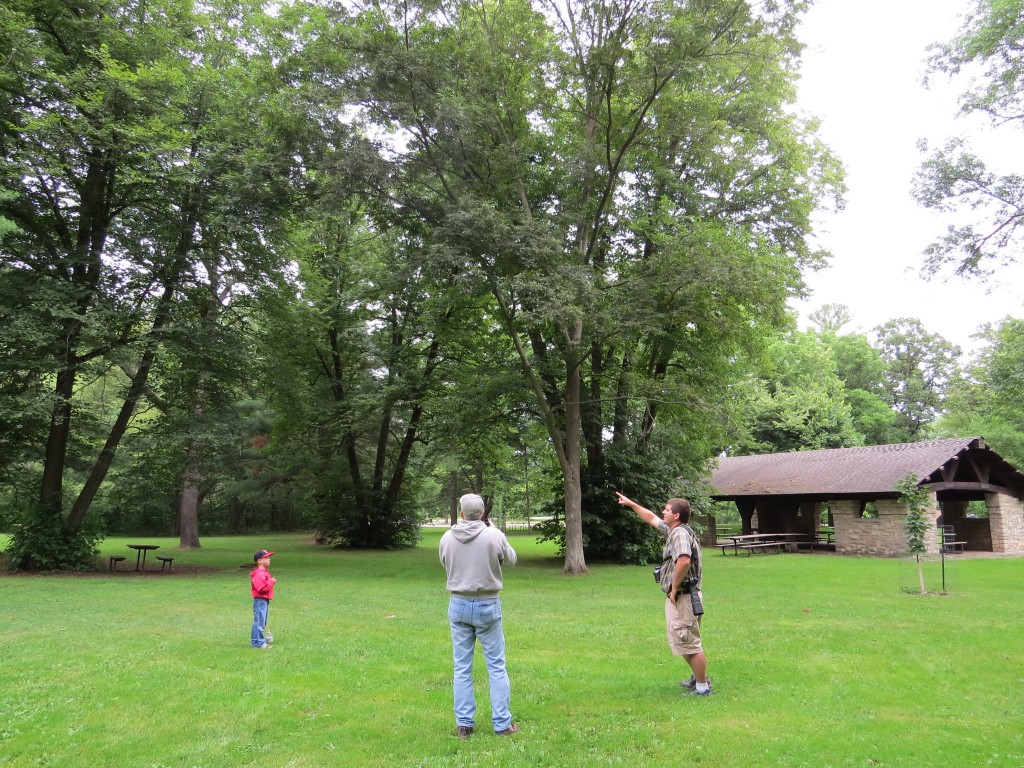 This was a monumental lifer, and now our trip had been made complete. All the birders there that morning got to see this cool warbler. Everything afterward was a bit more relaxed. There was more conversation among the birders, and we all just continued to watch this family of birds. I’m not sure what kind of conversations Evan had while I was taking pictures, but one guy told me how impressed he was with Evan’s bird knowledge and another one politely ate a lone Pringle chip that Evan offered him. Here Malcolm is quizzing Evan about some other bird.
This was a monumental lifer, and now our trip had been made complete. All the birders there that morning got to see this cool warbler. Everything afterward was a bit more relaxed. There was more conversation among the birders, and we all just continued to watch this family of birds. I’m not sure what kind of conversations Evan had while I was taking pictures, but one guy told me how impressed he was with Evan’s bird knowledge and another one politely ate a lone Pringle chip that Evan offered him. Here Malcolm is quizzing Evan about some other bird.
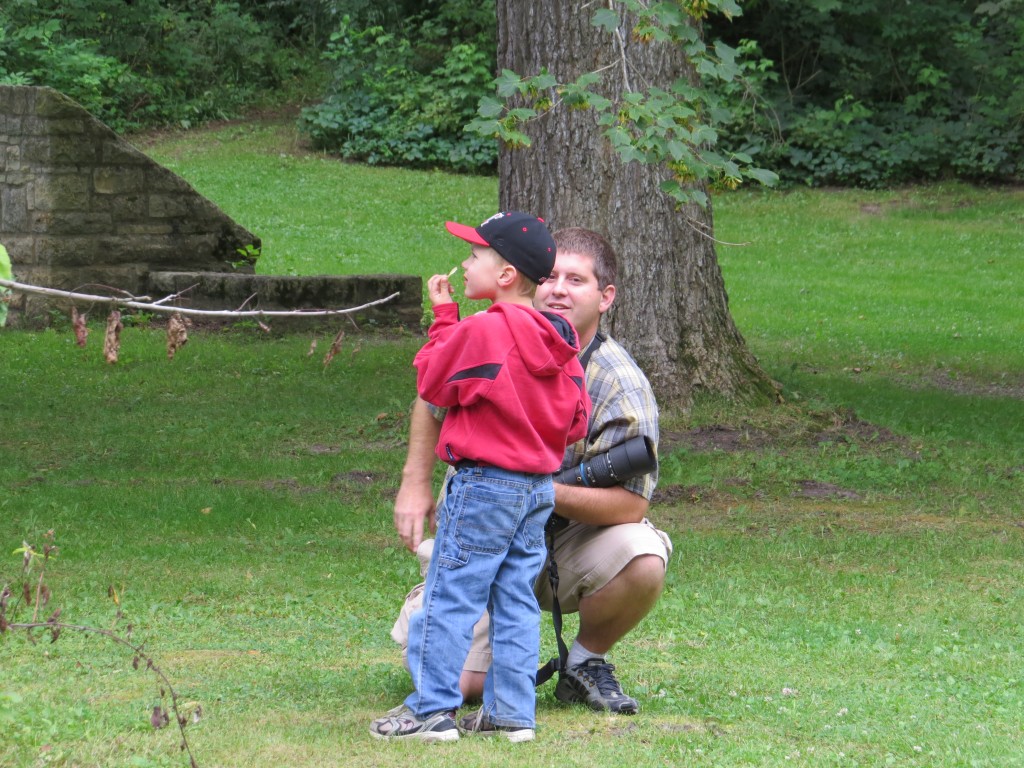 With a lighter mood all around, we decided to make one more try for that Louisiana Waterthrush. We didn’t end up finding it this time either, but it was nice to have more time to hang out and visit. Finally, though, it was time to part company with Malcolm. It was a phenomenal trip. Evan’s trip was made by getting two state park patches for his ruck sack. Mine was made by getting a chance to bird with a friend I hadn’t seen in over a decade. Seeing the target bird was the icing on the cake for both of us.
With a lighter mood all around, we decided to make one more try for that Louisiana Waterthrush. We didn’t end up finding it this time either, but it was nice to have more time to hang out and visit. Finally, though, it was time to part company with Malcolm. It was a phenomenal trip. Evan’s trip was made by getting two state park patches for his ruck sack. Mine was made by getting a chance to bird with a friend I hadn’t seen in over a decade. Seeing the target bird was the icing on the cake for both of us.
Another Lifer in the Bank Despite a Terrible Day
One might think from reading this blog that we go birding all the time. While we do like to get out whenever we can, today was not supposed to be a birding day. Instead we were supposed to be packing and getting ready to join my entire immediate family for a reunion vacation in the Apostle Islands off the north shore of Wisconsin. Getting the entire family together is a biennial occurrence since my sister lives in Nigeria and only comes back to the U.S. every other year. The kids were excited to see all their cousins. I was excited to hang out with both my siblings and their families. I was also excited to get another crack at getting the Blue-headed Vireo, maybe photograph a Mourning Warbler, and possibly see the endangered Piping Plover. But we don’t always have control over the circumstances of our lives. Last night Marin’s illness morphed from just a fever into a horrendous case of itchy feet. She writhed all night long and got no more than an hour of sleep. We tried every remedy we could think of to bring relief to her feet. Nothing worked.
The itchiness only intensified in the morning, so I brought her in to the doctor. The conclusion? Hand, Foot, and Mouth Disease – a highly contagious viral infection of which there is no topical relief. Only time can alleviate the symptoms of this nasty bug. When I asked the doctor how long Marin had to be away from other children, I was dumbstruck by the response: one week. That was the length of this reunion vacation. I knew then that we would not be joining my family. There wouldn’t be an Apostle Islands birding adventure. It was devastating. Even if Marin did start feeling better, we couldn’t risk spreading the virus to her cousins.
While that news was tough enough to take, Marin’s feet weren’t getting any relief and we were all subject to a day of incessant screaming and crying. Evan became a TV zombie logging in nearly 8 hours on the tube while Melissa and I spent our day trying to somehow help and console someone that couldn’t be helped or consoled. On top of the pain, she was exhausted. She had been awake for well over 36 hours. It was an awful day.
Since Marin was calm in the car when I took her to the doctor, I suggested we take a drive to hopefully get her to relax. After all, she often will easily fall asleep in the car when she won’t nap at home. She needed rest. We needed a reprieve. So we went birding even though we never were supposed to. Today we birded to escape – to escape the disappointment, to escape the screams, to escape the TV and the confines of the house.
My hypothesis about Marin being calm in the car was wrong. She continued to writhe in agony for nearly 45 minutes. Finally, after one scream-fest to end all, her body gave in to sleep. Who cares if we saw a bird; we were finally catching a break. But we were birding, kind of. I took a long route to check Joel’s marked locations for the Wood Thrush and the very rare Henslow’s Sparrow. We birded for the thrush by sight only as Marin was still screaming at that point. Even if I was willing to roll down a window, we wouldn’t have heard a bird.
It was fun to find another Indigo Bunting. I seem to find them each time I go out now. Just a couple months ago I had never seen this cool bird before.
As we neared the location of the Henslow’s Sparrow in our now quiet van, this caught my eye:
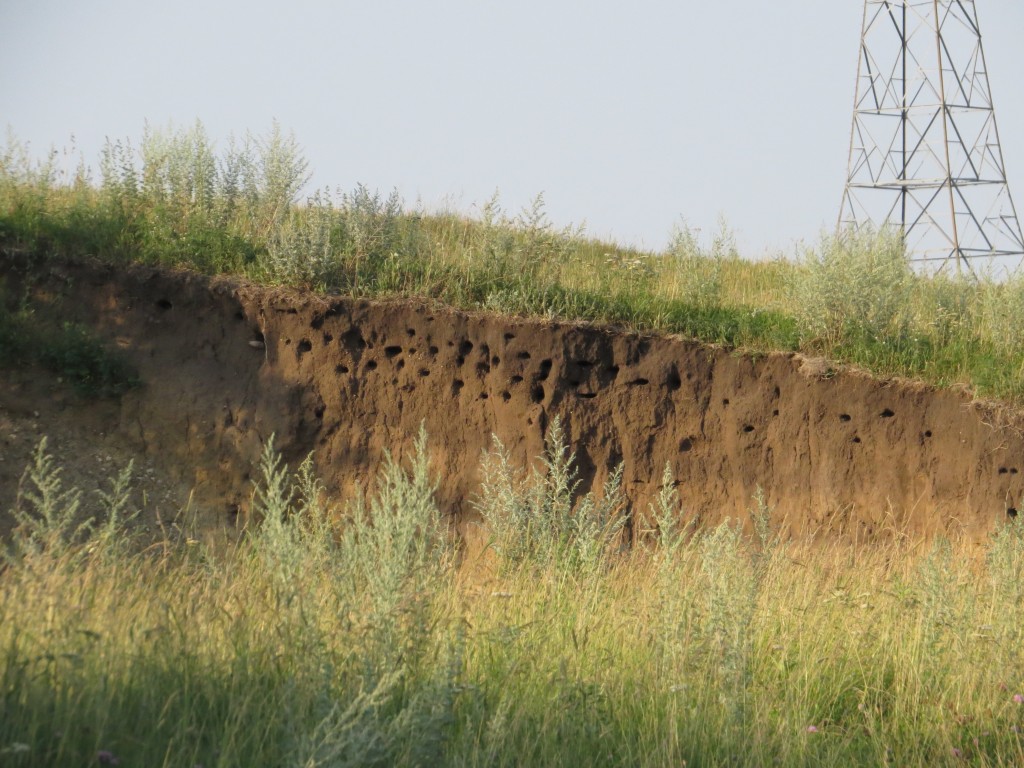 I recognized it as being a nesting colony for Bank Swallows. I got my Bank Swallow lifer this spring, but Evan still needed it. The two of us hopped out of the van while the girls slept inside. After watching for just a couple of minutes, we started to see swallows flying around and diving into the holes. I had the camera zoomed to the max, but here you can see three (possibly young) birds, waiting inside one of the cavities.
I recognized it as being a nesting colony for Bank Swallows. I got my Bank Swallow lifer this spring, but Evan still needed it. The two of us hopped out of the van while the girls slept inside. After watching for just a couple of minutes, we started to see swallows flying around and diving into the holes. I had the camera zoomed to the max, but here you can see three (possibly young) birds, waiting inside one of the cavities. 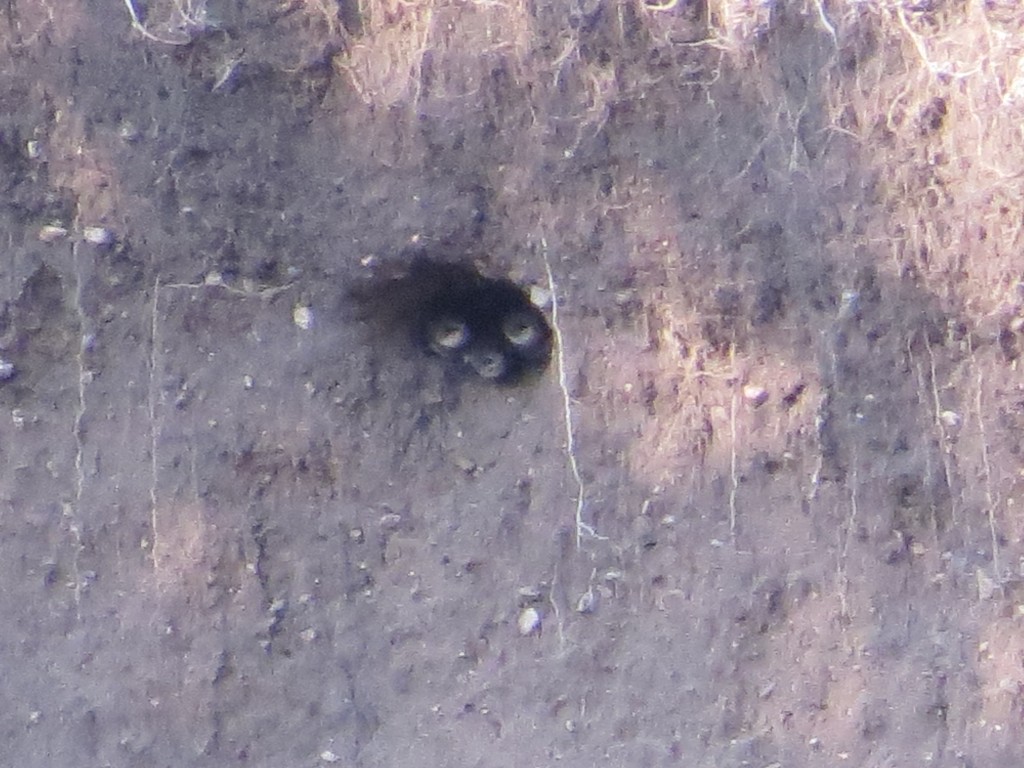 The habitat indicated Bank Swallow, but I wanted my conclusive proof that that’s the bird we were looking at. With much difficulty I finally got the photographs I wanted to help me make that determination. Do you see the dark band across the breast? That’s the signature field mark of the Bank Swallow.
The habitat indicated Bank Swallow, but I wanted my conclusive proof that that’s the bird we were looking at. With much difficulty I finally got the photographs I wanted to help me make that determination. Do you see the dark band across the breast? That’s the signature field mark of the Bank Swallow.
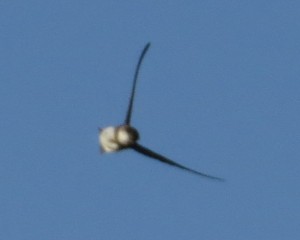
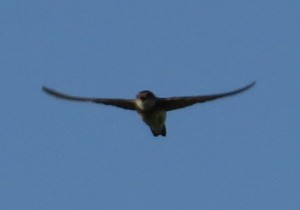 This was a nice find for this birding trip that we wish we weren’t on. We ended up striking out on the Henslow’s Sparrow. Oh well.
This was a nice find for this birding trip that we wish we weren’t on. We ended up striking out on the Henslow’s Sparrow. Oh well.
Who knows what the coming week will bring. We have several days’ worth of Plan Bs to come up with. I imagine we will try to knock off a few of the lifers that still remain in our part of the state. It definitely won’t be the same as chasing warblers and hunting an endangered species, but we will make the most of it.

